Mybatis-9.28
环境
-
JDK1.8
-
Mysql5.7
-
maven3.6.1
-
IDEA
回顾
- JDBC
- Mysql
- Java基础
- Maven
- Junit
SSM框架:配置文件。最好的方式:看官方文档。
1、简介
1.1、什么是Mybatis
- MyBatis 是一款优秀的持久层框架,
- 它支持自定义 SQL、存储过程以及高级映射。
- MyBatis 免除了几乎所有的 JDBC 代码以及设置参数和获取结果集的工作。MyBatis 可以通过简单的 XML 或注解来配置和映射原始类型、接口和 Java POJO(Plain Old Java Objects,普通老式 Java 对象)为数据库中的记录。
- MyBatis 本是apache的一个开源项目iBatis, 2010个项目由apache software foundatic迁移google code,并且改名为MyBatis 。
- 2013年11月迁移到Github
如何获得Mybatis
-
maven
<!-- https://mvnrepository.com/artifact/org.mybatis/mybatis --> <dependency> <groupId>org.mybatis</groupId> <artifactId>mybatis</artifactId> <version>3.5.10</version> </dependency> -
GitHub:https://github.com/
-
中文地址:https://mybatis.org/mybatis-3/zh/index.html
1.2、持久化
数据持久化
- 持久化就是将程序的数据在特久状态和瞬时状态转化的过程
- 内存:断电即失
- 数据库(jdbc),io文件持久化。
- 生活:冷藏。罐头
为什么需要需要持久化?
- 有一些对象,不能让他丢掉。
- 内存太贵了
1.3、持久层
Dao层,Service层,Controller层…
- 完成持久化工作的代码块
- 层界限十分明显。
1.4、为什么需要Mybatis?
- 方便
- 帮助程序猿将数据存入到数据库中。
- 传统的JDBC代码太复杂了。简化。框架。
- 不用Mybatis也可以。更容易上手。技术没有高低之分
- 优点
- 简单易学
- 灵活
- sql和代码的分离,提高了可维护性。
- 提供映射标签,支持对象与数据库的orm字段关系映射
- 提供对象关系映射标签,支持对象关系组建维护
- 提供xml标签,支持编写动态sql。
最重要的一点:使用的人多!
Spring SpringMVC SpringBoot
2、第一个Mybatis程序
思路:搭建环境-> 导入Mybatis-> 编写代码-> 测试!
2.1、搭建环境
新建项目
-
新建一个普通的maven项目
-
删除src目录
-
导入依赖
<!--导入依赖--> <dependencies> <!--mysql驱动--> <dependency> <groupId>mysql</groupId> <artifactId>mysql-connector-java</artifactId> <version>5.1.47</version> </dependency> <!--junit--> <dependency> <groupId>junit</groupId> <artifactId>junit</artifactId> <version>4.12</version> </dependency> <!-- https://mvnrepository.com/artifact/org.mybatis/mybatis --> <dependency> <groupId>org.mybatis</groupId> <artifactId>mybatis</artifactId> <version>3.5.10</version> </dependency> </dependencies>
2.2、创建一个模块
第一步:resources配置文件mybatis-config.xml
第二步:MabstisUtils工具类
第三步:实体类-User
第四步:接口UserMapper.xml
第五步:测试
-
编写mybatis的核心配置文件
[外链图片转存失败,源站可能有防盗链机制,建议将图片保存下来直接上传(img-J62Z4VRC-1688039103969)(assets\1656466810356.png)]
mybatis-config.xml
<?xml version="1.0" encoding="UTF-8" ?>
<!DOCTYPE configuration
PUBLIC "-//mybatis.org//DTD Config 3.0//EN"
"http://mybatis.org/dtd/mybatis-3-config.dtd">
<!--configuration-->
<configuration>
<environments default="development">
<environment id="development">
<transactionManager type="JDBC"/>
<dataSource type="POOLED">
<property name="driver" value="com.mysql.jdbc.Driver"/>
<property name="url" value="jdbc:mysql://localhost:3306/mybatis?useSSL=true&useUnicode=true=true&characterEncoding=UTF-8"/>
<property name="username" value="root"/>
<property name="password" value="newpassword"/>
</dataSource>
</environment>
</environments>
</configuration>
-
编写mybatis工具类
MybatisUtils.java
//从 SqlSessionFactory 中获取 SqlSession public class MybatisUtils { private static SqlSessionFactory sqlSessionFactory; //初始就加载 static块 static { try { //1.使用Mybatis获取sqlSessionFactory对象 String resource = "mybatis-config.xml"; InputStream inputStream = Resources.getResourceAsStream(resource); sqlSessionFactory = new SqlSessionFactoryBuilder().build(inputStream); } catch (IOException e) { e.printStackTrace(); } } //既然有了 SqlSessionFactory,顾名思义,我们可以从中获得 SqlSession 的实例。 // SqlSession 提供了在数据库执行 SQL 命令所需的所有方法。你可以通过 SqlSession 实例来直接执行已映射的 SQL 语句 public static SqlSession getSqlSession(){ return sqlSessionFactory.openSession(); } }
2.3、编写代码
-
实体类User
public class User { private int id; private String name; @Override public String toString() { return "User{" + "id=" + id + ", name='" + name + '\'' + ", pwd='" + pwd + '\'' + '}'; } public User(int id, String name, String pwd) { this.id = id; this.name = name; this.pwd = pwd; } private String pwd; public int getId() { return id; } public void setId(int id) { this.id = id; } public String getName() { return name; } public void setName(String name) { this.name = name; } public String getPwd() { return pwd; } public void setPwd(String pwd) { this.pwd = pwd; } } -
Dao接口
UserDao.java
public interface UserDao { List<User> getUserList(); } -
接口实现类 由原来的UserDaoImpl转变为一个Mapper配置文件
UserMapper.xml
<?xml version="1.0" encoding="UTF-8" ?> <!DOCTYPE mapper PUBLIC "-//mybatis.org//DTD Mapper 3.0//EN" "http://mybatis.org/dtd/mybatis-3-mapper.dtd"> <!--namespace=绑定一个对应的Dao/Mapper接口--> <!--相当于实现了接口--> <mapper namespace="com.l_kai.dao.UserDao"> <select id="getUserList" resultType="com.l_kai.pojo.User"> select * from mybatis.user </select> </mapper>
2.4、测试
新建文件要对应好,方便查看
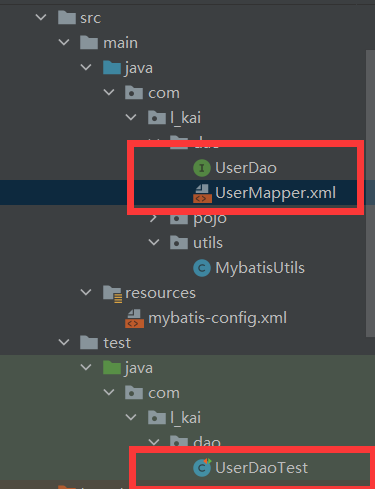
注意点:
org.apache.ibatis.binding.BindingException: Type interface com.l_kai.dao.UserDao is not known to the MapperRegistry.
MapperRegistry是什么?
核心配置文件中注册mappers
mybatis-config.xml
<mappers>
<mapper resource="com/l_kai/dao/UserMapper.xml"></mapper>
</mappers>
-
Junit测试
public class UserDaoTest { @Test public void test() { //第一步:获得sqlSession对象 SqlSession sqlSession = MybatisUtils.getSqlSession(); //方式一:getMapper UserDao userDao = sqlSession.getMapper(UserDao.class); List<User> userList = userDao.getUserList(); for (User user : userList) { System.out.println(user); } //关闭SqlSession sqlSession.close(); } }
可能会遇见的问题
-
配置文件没有注册
-
绑定接口错误
-
方法名不对
-
返回类型不对
-
maven导出资源出错
<build> <resources> <resource> <directory>src/main/resources</directory> <!--这个会把已经存在target /WEB-INF/classes中properties删除,应该变为include--> <includes> <include>**/*.properties</include> <include>**/*.xml</include> </includes> <filtering>false</filtering> </resource> <resource> <directory>src/main/java</directory> <includes> <include>**/*.properties</include> <include>**/*.xml</include> </includes> <filtering>false</filtering> </resource> </resources> </build>
3、CRUD
1、namespace
namespace中的包名要和Dao/mapper接口中的包名一致!

2、select
选择,查询语句
- id:就是对应的namespace中的方法名;
- resultType:Sql语句执行的返回值!
- parameterType:参数类型!
- 编写接口
- 编写对应的mapper中的sql语句
- 测试
3、Insert
4、delete
5、update
注意点: 增删改需要提交事物 sqlSession.commit();
xml是核心
UserMapper
public interface UserMapper {
//查询全部用户
List<User> getUserList();
//根据ID查询用户
User getUserById(int id);
//添加一个用户
int addUser(User user);
//修改用户
int modifyUser(User user);
//删除用户
int delUser(int id);
}
UserMapper.xml
<mapper namespace="com.l_kai.dao.UserMapper">
<select id="getUserList" resultType="com.l_kai.pojo.User">
select * from mybatis.user
</select>
<select id="getUserById" parameterType="int" resultType="com.l_kai.pojo.User">
select * from mybatis.user where id = #{id}
</select>
<!--参数名是User 所以就要写全路径名-->
<!--对象中的属性可以直接取出,既id,name,pwd-->
<insert id="addUser" parameterType="com.l_kai.pojo.User">
insert into mybatis.user (id, name ,pwd) values (#{id},#{name},#{pwd});
</insert>
<update id="modifyUser" parameterType="com.l_kai.pojo.User">
update mybatis.user
set name = #{name },pwd = #{pwd}
where id = #{id};
</update>
<delete id="delUser" parameterType="int" >
delete
from mybatis.user
where id = #{id};
</delete>
</mapper>
测试
public class UserDaoTest {
@Test
public void test() {
//第一步:获得sqlSession对象
SqlSession sqlSession = MybatisUtils.getSqlSession();
//方式一:getMapper
UserMapper userMapper = sqlSession.getMapper(UserMapper.class);
List<User> userList = userMapper.getUserList();
// //方式二:
// List<User> userList = sqlSession.selectList("com.l_kai.dao.UserMapper.getUserList");
for (User user : userList) {
System.out.println(user);
}
//关闭SqlSession
sqlSession.close();
}
@Test
public void getUserById() {
SqlSession sqlSession = MybatisUtils.getSqlSession();
UserMapper mapper = sqlSession.getMapper(UserMapper.class);//获得接口
User user = mapper.getUserById(1);
System.out.println(user);
sqlSession.close();
}
//增删改必需要提交事物
@Test
public void addUser(){
SqlSession sqlSession = MybatisUtils.getSqlSession();
UserMapper mapper = sqlSession.getMapper(UserMapper.class);
int res = mapper.addUser(new User(5, "邱龙", "1545623"));
if (res > 0){
System.out.println("提交成功");
}
//提交事物
sqlSession.commit();
sqlSession.close();
}
@Test
public void modifyUser(){
SqlSession sqlSession = MybatisUtils.getSqlSession();
UserMapper mapper = sqlSession.getMapper(UserMapper.class);
mapper.modifyUser(new User(4,"何鹏","123465"));
sqlSession.commit();
sqlSession.close();
}
@Test
public void delUser(){
SqlSession sqlSession = MybatisUtils.getSqlSession();
UserMapper mapper = sqlSession.getMapper(UserMapper.class);
mapper.delUser(4);
sqlSession.commit();
sqlSession.close();
}
}
6、分析错误
- 标签不要错
- resource中用 / namespace用 点
- 程序配置文件要符合规范
- 输出的xml文件中存在乱码问题
7、万能的Map
假设,我们的实体类,或者数据库中的表,字段或者参数过多,我们应当考虑使用map
如:
UserMapper
//添加一个用户
int addUser2(Map<String,Object> map);
UserMapper.xml
<insert id="addUser2" parameterType="map">
insert into mybatis.user (id, name ,pwd) values (#{uid},#{username},#{password});
</insert>
测试
@Test
public void addUser2(){
SqlSession sqlSession = MybatisUtils.getSqlSession();
UserMapper mapper = sqlSession.getMapper(UserMapper.class);
Map<String,Object> map = new HashMap<String,Object>();
map.put("uid",6);
map.put("username","何鹏");
map.put("password","132465");
mapper.addUser2(map);
//提交事物
sqlSession.commit();
sqlSession.close();
}
map传递参数直接在sql中取出key即可!【parameterType=“map”】
对象传递传递参数,直接在sql中取对象的属性即可!【parameterType=“com.l_kai.pojo.User”】
只有一个基本类型参数的情况下,可以直接在sql中取到!【parameterType可不写】
多个参数用Map, 或者注解
8、模糊查询怎么写
- Java代码执行的时候,传递通配符 % %
List<User> getUserList2(String value);
<select id="getUserList2" resultType="com.l_kai.pojo.User">
select *
from USER
where name like #{value};
</select>
List<User> userList = mapper.getUserList2("%李%");
-
在sql拼接中使用通配符!
这个容易被Sql注入
<select id="getUserList2" resultType="com.l_kai.pojo.User"> select * from USER where name like "%"#{value}"%"; </select>
List<User> userList = mapper.getUserList2("李");
4、配置解析
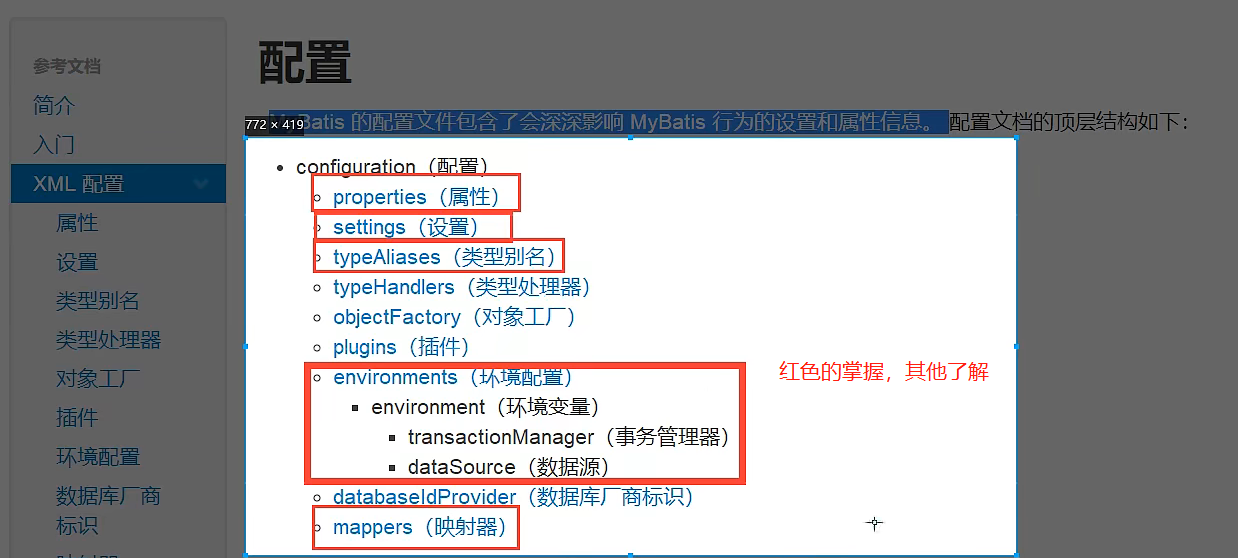
4.1、核心配置文件
- mybatis-config.xml
- MyBatis 的配置文件包含了会深深影响 MyBatis 行为的设置和属性信息。
configuration(配置)
properties(属性)
settings(设置)
typeAliases(类型别名)
typeHandlers(类型处理器)
objectFactory(对象工厂)
plugins(插件)
environments(环境配置)
environment(环境变量)
transactionManager(事务管理器)
dataSource(数据源)
databaseIdProvider(数据库厂商标识)
mappers(映射器)
4.2、环境配置(environments)
MyBatis可以配置成适应多种环境
不过要记住:尽管可以配置多个环境,但每个SqlSessionFactory实例只能选择一种环境。
学会使用配置多套运行环境!
Mybatis默认的事务管理器就是JDBC, 连接池:POOLED
4.3、属性(properties)
我们可以通过properties属性来实现引用配置文件
这些属性都是可外部配置且可动态替换的,既可以在典型的ava属性文件中配置,亦可通过properties元素的子元素来传递。【db.properties】
必须按照顺序来写
properties必须在第一个

新建db.properties
driver=com.mysql.jdbc.Driver
url=jdbc:mysql://localhost:3306/mybatis?useSSL=true&useUnicode=true&characterEncoding=UTF-8
username=root
password=newpassword
在核心配置文件中引入
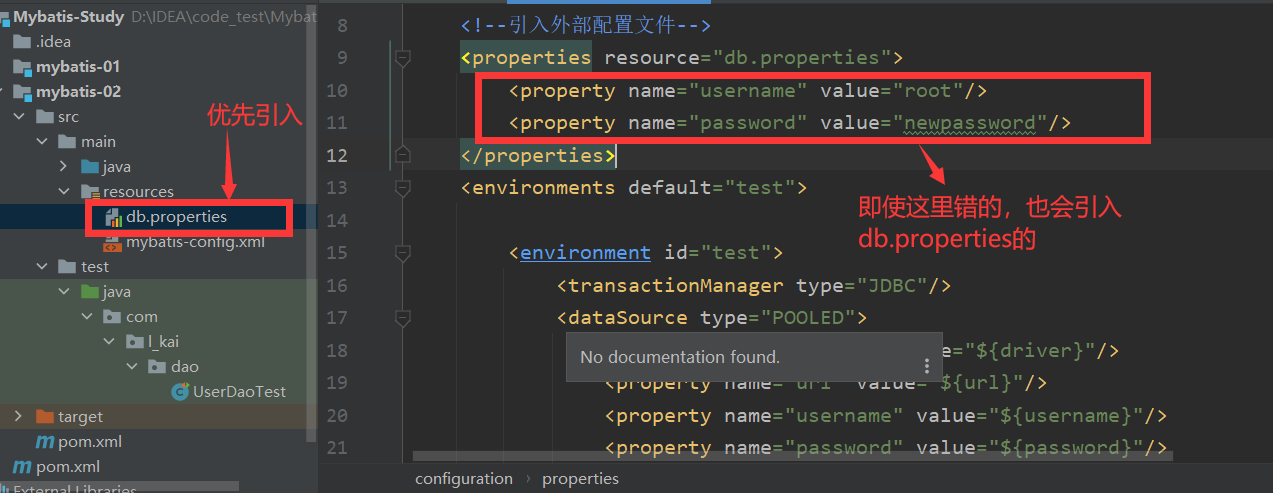
<!--引入外部胤置文件-->
<properties resource="db.properties">
<property name="username" value="root"/>
<property name="password" value="newpassword"/>
</properties>
<!--引入外部配置文件-->
<properties resource="db.properties"/>
<environments default="test">
<environment id="test">
<transactionManager type="JDBC"/>
<dataSource type="POOLED">
<property name="driver" value="${driver}"/>
<property name="url" value="${url}"/>
<property name="username" value="${username}"/>
<property name="password" value="${password}"/>
</dataSource>
</environment>
</environments>
映入配置文件的几种方式:
- 可以直接引入外部文件
- 可以在其中增加一些属性配置
- 如果两个文件有同一个字段,优先使用外部配置文件的!
4.4、类型别名(typeAliases)
- 类型别名是为Java类型设置一个短的名字。
- 存在的意义仅在于用来减少类完全限定名的冗余。
<!--第三个位置-->
<!--可以起别名-->
<typeAliases>
<typeAlias type="com.l_kai.pojo.User" alias="User"/>
</typeAliases>
也可以指定一个包名,MyBatis会在包名下面搜索需要的Java Bean 比如:
扫描实体类的包,它的默认别名就为这个类的 类名小写
<typeAliases>
<package name="com.l_kai.pojo"/>
</typeAliases>

第一种适合:类较少的情况
第二种适合:类比较多
第一种可以DIY别名,第二种 不行 如果非要改 需要在实体类上增加注解
[外链图片转存失败,源站可能有防盗链机制,建议将图片保存下来直接上传(img-JezozmGh-1688039103975)(https://gitee.com/l_kai916/assets/raw/master/assets/1656494947332.png)]

4.5、设置
这是 MyBatis 中极为重要的调整设置,它们会改变 MyBatis 的运行时行为。


4.6、其他配置
mybati-Plus

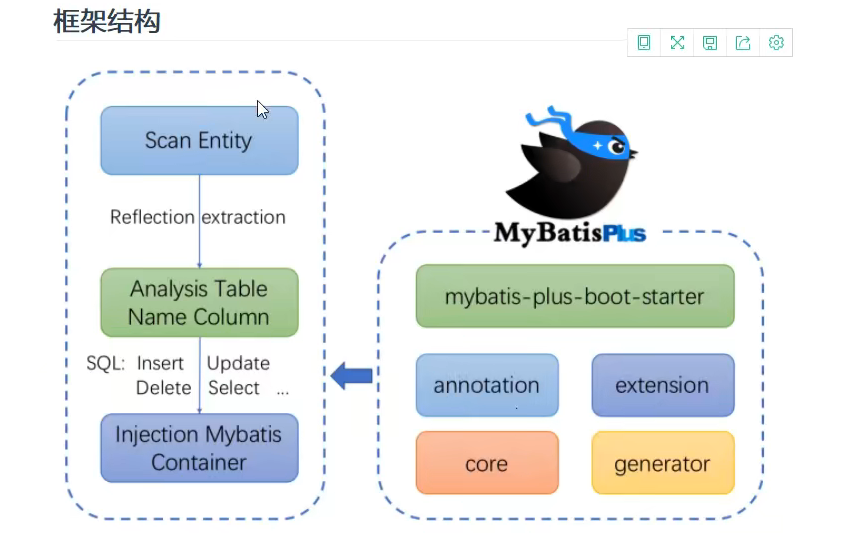
4.7、映射器 (mappers)
MapperRegister注册绑定我们的mapper文件
方式一:【推荐使用】
<mappers>
<mapper resource="com/l_kai/dao/UserMapper.xml"></mapper>
</mappers>
方式二:使用class文件实现注册
<mappers>
<!--<mapper resource="com/l_kai/dao/UserMapper.xml"></mapper>-->
<mapper class="com.l_kai.dao.UserMapper"/>
</mappers>
注意点:
- 接口和它的配置文件必须同名
- 接口和它的配置文件必须在同一个包下
方式三:使用扫描包进行注册绑定
[外链图片转存失败,源站可能有防盗链机制,建议将图片保存下来直接上传(img-SootSio5-1688039103979)(https://gitee.com/l_kai916/assets/raw/master/assets/874445ebf15942d2eb68171717efb012.png)]
<mappers>
<!-- <mapper resource="com/l_kai/dao/UserMapper.xml"></mapper>-->
<!-- <mapper class="com.l_kai.dao.UserMapper"/>-->
<package name="com.l_kai.dao"/>
</mappers>
注意点同方式二:
- 接口和它的配置文件必须同名
- 接口和它的配置文件必须在同一个包下
练习时间:(重点)
- 将数据库配置文件外部引入
- 实体类别名
- 保证UserMapper接口和UserMapper.Xml改为一致!并且放在同一个包下!
4.8、生命周期和作用域(scope)
生命周期和作用域是至关重要的,因为错误的使用会导致非常严重的并发问题。
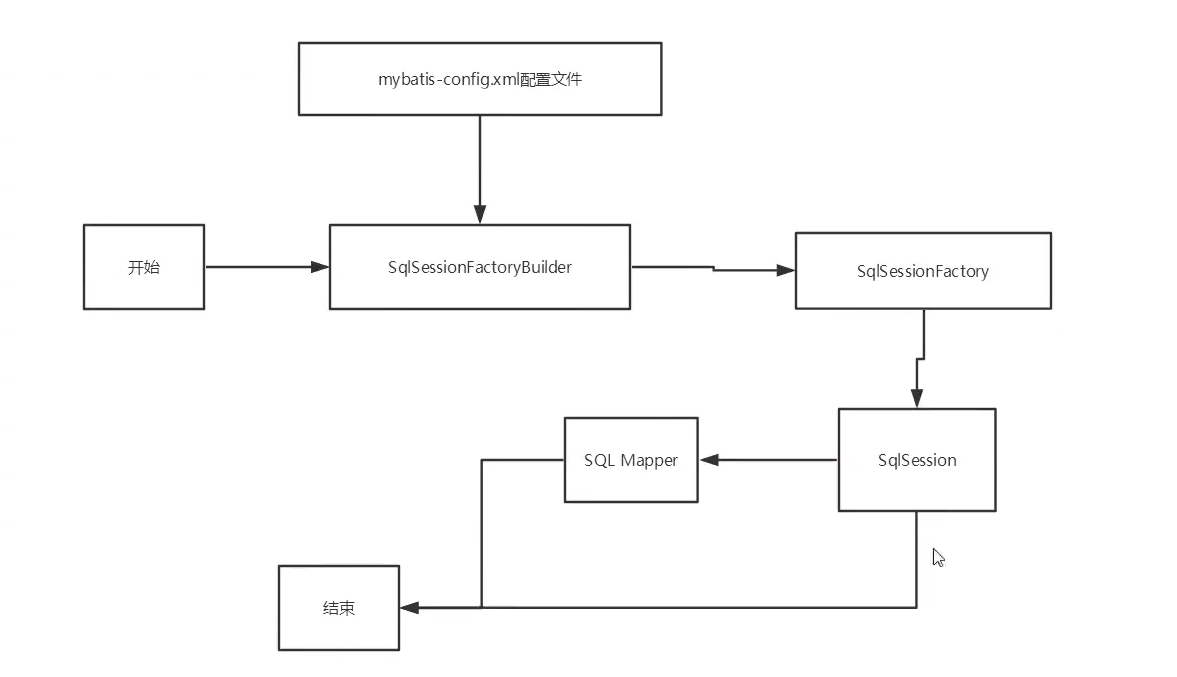
SqlSessionFactoryBuilder:
- 但创建了SqlSessionFactory,就不再需要它了
- 局部变量
SqlSessionFactory:
- 说白了就是可以想象为:数据库连接池
- SqlSessionFactory一旦被创建就应该在应用的运行期间一直存在,没有任何理由丢弃它或重新创建另一个实例。
- 因此SqlSessionFactory的最佳作用域是应用作用域。
- 最简单的就是使用单例模式或者静态单例模式。
SqlSession:
-
连接到连接池的一个请求!
-
SqlSession的实例不是线程安全的,因此是不能被共享的,所以它的最佳的作用域是请求或方法作用域。
-
用完之后需要赶紧关闭,否则资源被占用!
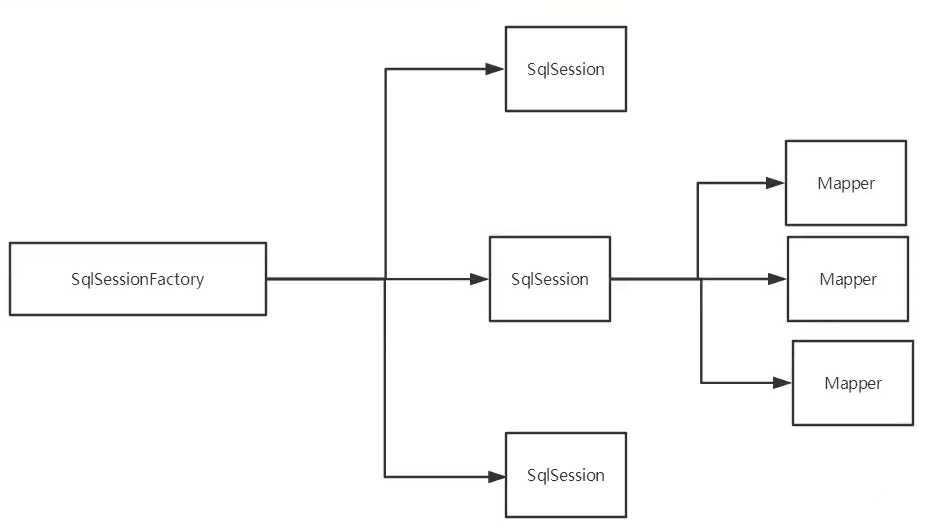
5、解决属性名和字段名不一致的问题
1.问题
数据库中的字段
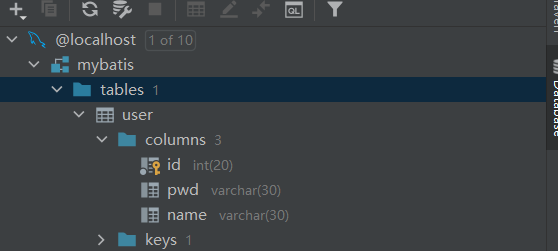
新建一个项目,拷贝之前的,测试实体类字段不一致的情况
public class User {
private int id;
private String name;
private String password;
}
<select id="getUserById" parameterType="int" resultType="com.l_kai.pojo.User">
select * from mybatis.user where id = #{id}
/* 类型处理器转换
select id,name,pwd from mybatis.user where id = #{id} 这里相当于是这句话,而改了User中改了pwd 就找不到所以打印出null */
</select>
@Test
public void getUserById(){
SqlSession sqlSession = MybatisUtils.getSqlSession();
UserMapper mapper = sqlSession.getMapper(UserMapper.class);
User user = mapper.getUserById(7);
System.out.println(user);
sqlSession.close();
}

解决方法:
- 起别名 pwd as password () 简单但是方法笨
<select id="getUserById" parameterType="int" resultType="com.l_kai.pojo.User">
select id,name,pwd as password from mybatis.user where id = #{id}
</select>

2、resultMap
结果集映射
id name pwd
id name password
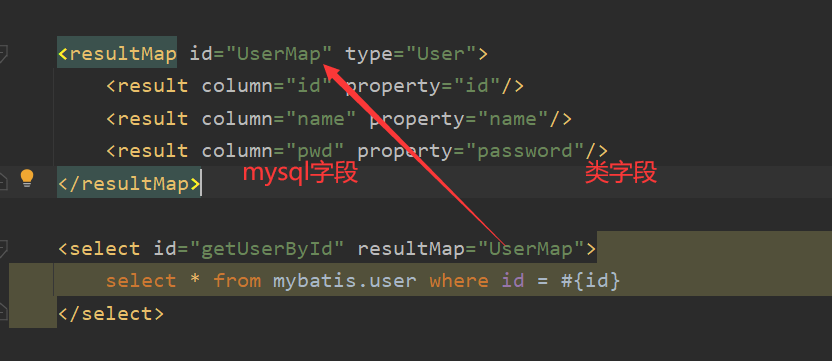
<resultMap id="UserMap" type="User">
<result column="id" property="id"/>
<result column="name" property="name"/>
<result column="pwd" property="password"/>
</resultMap>
<select id="getUserById" parameterType="int" resultMap="UserMap">
select * from mybatis.user where id =#{id}
</select>
- resultMap元素是MyBatis中最重要最强大的元素
- ResultMap的设计思想是,对于简单的语句根本不需要配置显式的结果映射,而对于复杂一点的语句只需要描述它们的关系就行了。
- ResultMap最优秀的地方在于,虽然你已经对它相当了解了,但是根本就不需要显式地用到他们。
如果世界总是这么简单就好了
6、日志
6.1、日志工厂
如果一个数据库操作,出现了异常,我们需要排错。日志就是最好的助手!
曾经:sout、debug
现在:日志工厂!

- SLF4J |
- LOG4J【掌握】
- LOG4J2 |
- JDK_LOGGING |
- COMMONS_LOGGING |
- STDOUT_LOGGING | 【掌握】
- NO_LOGGING

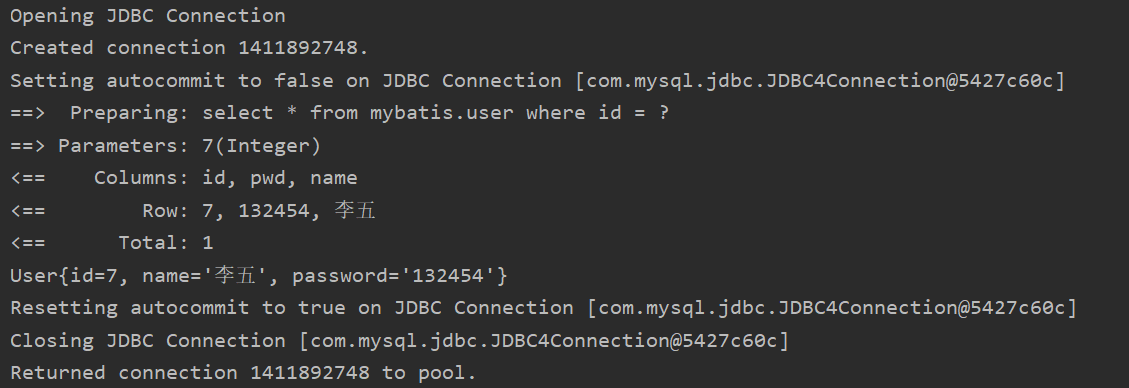
6.2、LOG4J
什么是Log4j?
- Log4j是Apache的一个开源项目,通过使用Log4j,我们可以控制日志信息输送的目的地是控制台、文件、GUI组件
- 我们也可以控制每一条日志的输出格式:
- 通过定义每一条日志信息的级别,我们能够更加细致地控制日志的生成过程。
- 通过一个配置文住来灵活地进行配置,而不需要修改应用的代码。
-
先导入log4j的包
<!-- https://mvnrepository.com/artifact/log4j/log4j --> <dependency> <groupId>log4j</groupId> <artifactId>log4j</artifactId> <version>1.2.17</version> </dependency> -
log4j.properties
Log4j框架配置文件log4j.properties配置使用详解
https://blog.csdn.net/eagleuniversityeye/article/details/80582140
#将等级为DEBUG的日志信息输出到console和file这两个目的地,console和file的定义在下面的代码
log4j.rootLogger=DEBUG,console,file
#控制台输出的相关设置
log4j.appender.console = org.apache.log4j.ConsoleAppender
log4j.appender.console.Target = System.out
log4j.appender.console.Threshold=DEBUG
log4j.appender.console.layout = org.apache.log4j.PatternLayout
log4j.appender.console.layout.ConversionPattern=[%c]-%m%n
# 文件输出的相关设置
log4j.appender.file = org.apache.log4j.RollingFileAppender
log4j.appender.file.File=./log/kai.log
log4j.appender.file.MaxFileSize=10mb
log4j.appender.file.Threshold=DEBUG
log4j.appender.file.layout=org.apache.log4j.PatternLayout
log4j.appender.file.layout.ConversionPattern=[%p][%d{yy-MM-dd}][%c]%m%n
# 日志输出级别
log4j.logger.org.mybatis=DEBUG
log4j.logger.java.sql=DEBUG
log4j.logger.java.sql.Statement=DEBUG
log4j.logger.java.sql.ResultSet=DEBUG
log4j.logger.java.sql.PreparedStatement=DEBUG
- 配置log4j为日志的实现
<settings>
<setting name="logImpl" value="LOG4J"/>
</settings>
- log4j的使用!直接测试运行刚才的查询
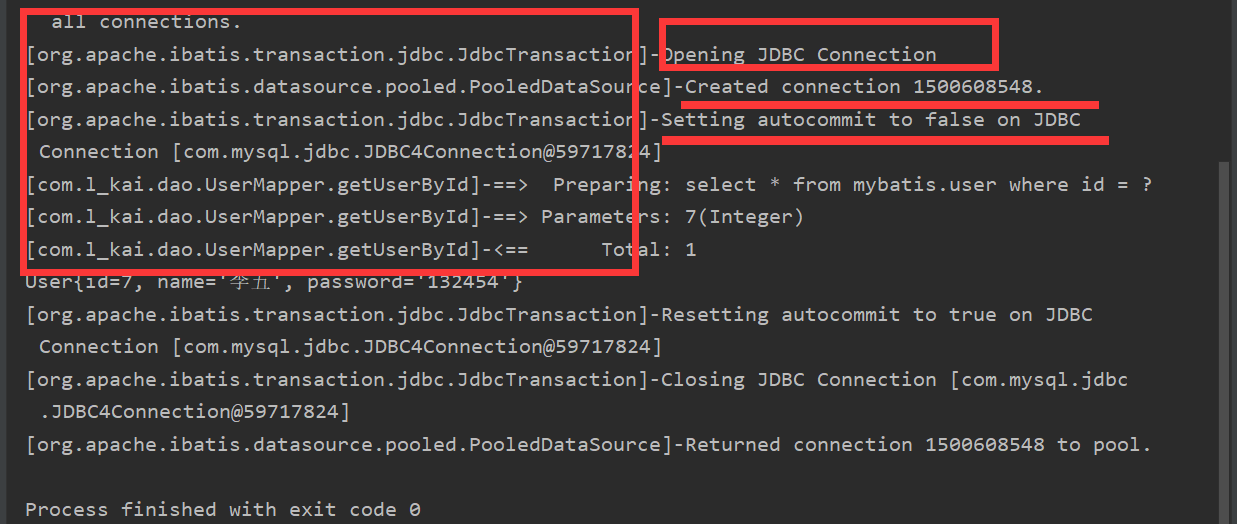
简单使用
-
在要使用的Log4j的类中,导入包import org.apache.log4j.Logger;
-
日志对象,参数为当前的class
static Logger logger = Logger.getLogger(UserDaoTest.class); -
日志级别
logger.info("info:进入了testLog4j"); logger.debug("debug:进入了testLog4j"); logger.error("error:进入了testLog4j");测试:
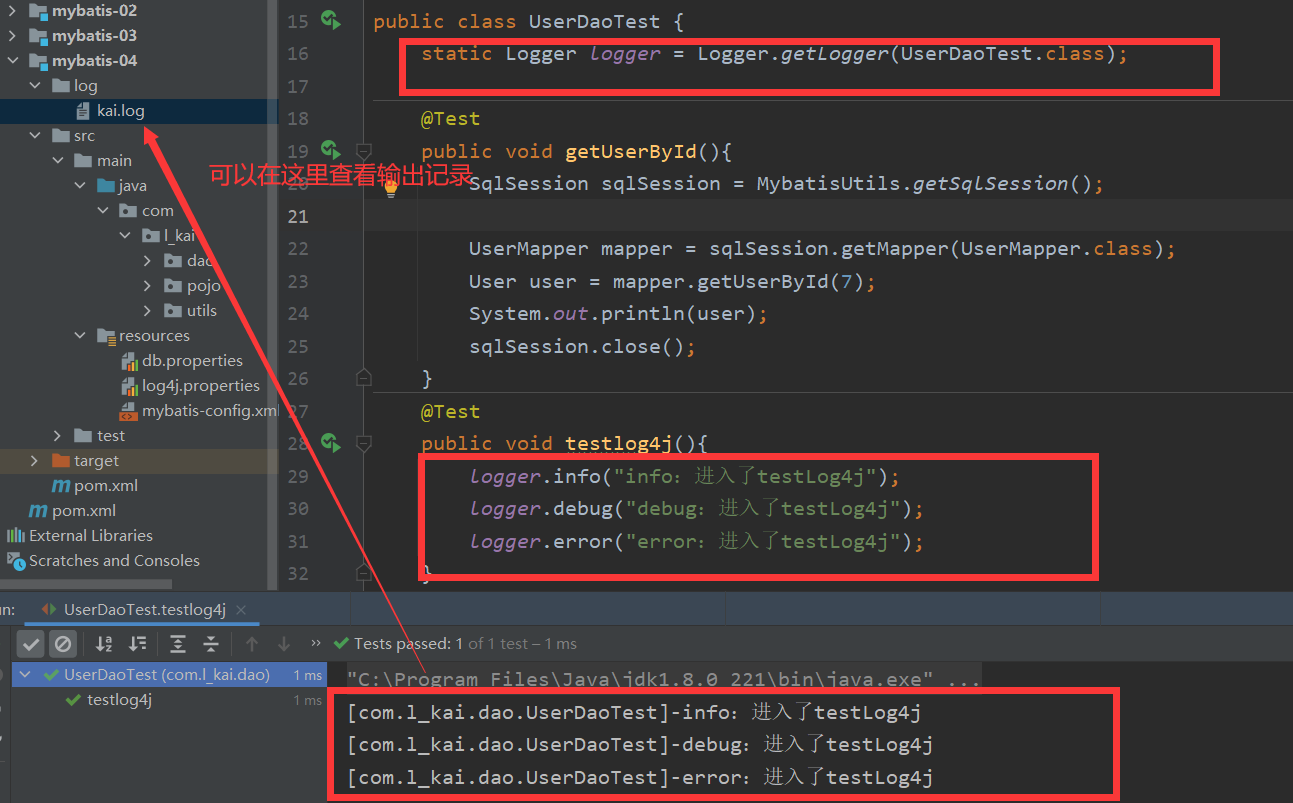
[外链图片转存失败,源站可能有防盗链机制,建议将图片保存下来直接上传(img-3hA9H8Qt-1688039103985)(https://gitee.com/l_kai916/assets/raw/master/assets/1656553948224.png)]
7、分页
思考:为什么要分页?
- 减少数据的处理量,处理些显示些
7.1使用limit分页
语法:SELECT * FROM user limit startindex,pagesize;
SELECT from user limit 3;#[0,n] 0开始三个数
使用Mybatis实现分页,核心SQL
-
接口
//分页 List<User> getUserLimit(Map<String,Integer> map); -
mapper.xml
<!--分页--> <select id="getUserLimit" resultMap="UserMap" parameterType="map"> select * from mybatis.user limit #{startIndex},#{pageSize} </select> -
测试
@Test public void getUserLimit(){ SqlSession sqlSession = MybatisUtils.getSqlSession(); UserMapper mapper = sqlSession.getMapper(UserMapper.class); HashMap<String, Integer> map = new HashMap<String, Integer>(); map.put("startIndex",0); map.put("pageSize",2); List<User> userLimit = mapper.getUserLimit(map); for (User user : userLimit) { System.out.println(user); } sqlSession.close();
7.2、RowBounds分页(不建议开发中使用)
不再使用SQL实现分页
-
接口
//RowBounds分页 List<User> getUserByRowBounds(); -
mapper.xml
<!--RowBounds分页--> <select id="getUserByRowBounds" resultMap="UserMap"> select * from mybatis.user </select> -
测试
//Rowbounds分页 @Test public void getUserByRowBounds(){ SqlSession sqlSession = MybatisUtils.getSqlSession(); //RowBounds实现 RowBounds rowBounds = new RowBounds(1, 2); //通过Java代码层面实现分页 List<User> userlist = sqlSession.selectList("com.l_kai.dao.UserMapper.getUserByRowBounds",null,rowBounds); for (User user : userlist) { System.out.println(user); } sqlSession.close(); }[外链图片转存失败,源站可能有防盗链机制,建议将图片保存下来直接上传(img-Vmze14E8-1688039103986)(https://gitee.com/l_kai916/assets/raw/master/assets/1656556958400.png)]
7.3、分页插件
MyBatis 分页插件 PageHelper https://pagehelper.github.io/
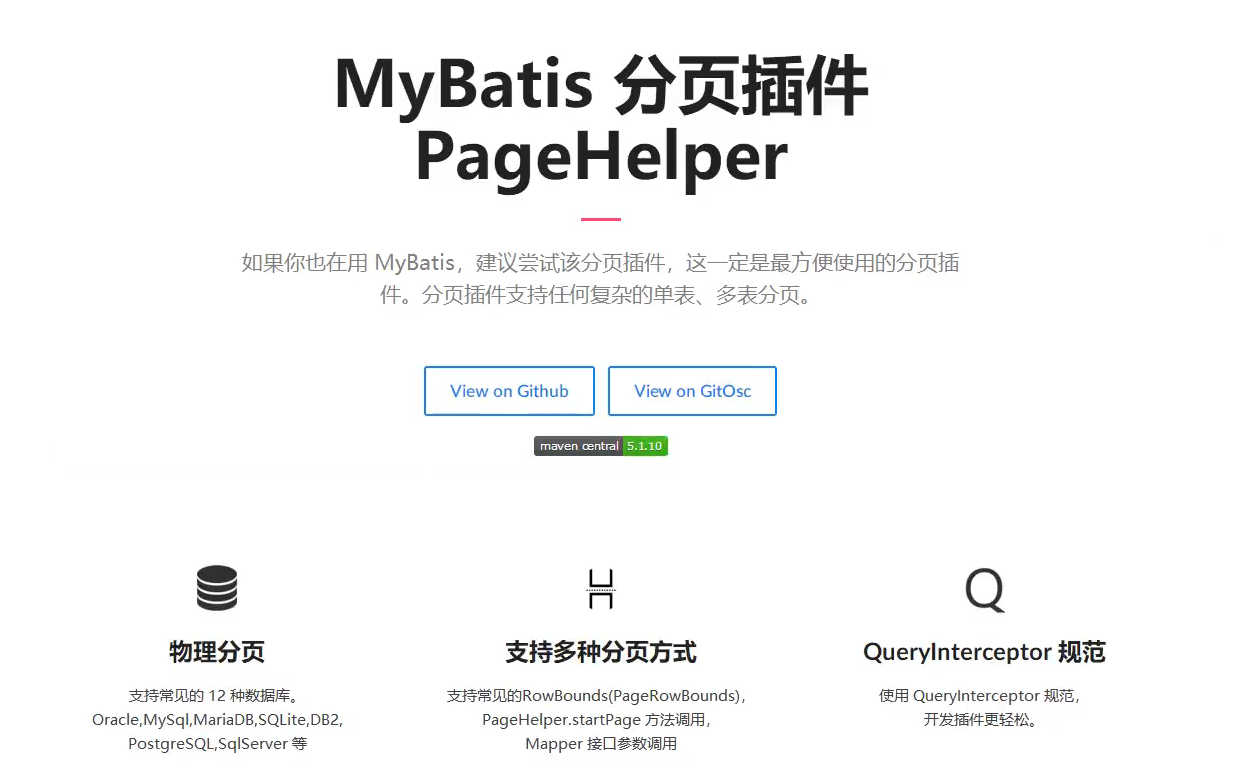
了解即可
8、使用注解开发
8.1、面向接口编程
- 大家之前都学过面向对象编程,也学习过接口,但在真正的开发中,很多时候我们会选择面向接口编程
- 根本原因:==解耦,==可拓展,提高复用,分层开发中,上层不用管具体的实现,大家都遵守共同的标准,使得开发变得容易,规范性更好
- 在一个面向对象的系统中,系统的各种功能是由许许多多的不同对象协作完成的。在这种情况下,各个对象内部是如何实现自己的,对系统设计人员来讲就不那么重要了;
- 而各个对象之间的协作关系则成为系统设计的关键。小到不同类之间的通信,大到各模块之间的交互,在系统设计之初都是要着重考虑的,这也是系统设计的主要工作内容。面向接口编程就是指按照这种思想来编程。
关于接口的理解
-
从更深层次的理解,应是定义(规范,约束)与实现(名实分离的原则)的分离。
-
接口的本身反映了系统设计人员对系统的抽象理解。
-
接口应有两类:
- 第一类是对一个个体的抽象,它可对应为一个抽象体(abstract class);
- 第二类是对一个个体某一方面的抽象,即形成一个抽象面(interface);
-
一个体有可能有多个抽象面。抽象体与抽象面是有区别的。
三个面向区别
- 面向对象是指,我们考虑问题时,以对象为单位,考虑它的属性及方法.
- 面向过程是指,我们考虑问题时,以一个具体的流程(事务过程)为单位,考虑它的实现
- 接口设计与非接口设计是针对复用技术而言的,与面向对象(过程)不是一个问题更多的体现就是对系统整体的架构
8.2、使用注解开发
使用注解查询



仅适用一些简单的sql语句,一般还是要通过xml文件来配置。。
本质:反射机制实现 (补)
底层:动态代理 (补)https://www.cnblogs.com/data-magnifier/p/14083193.html
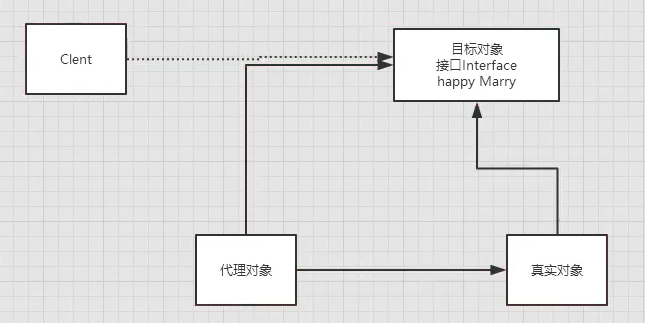
Mybitis详细执行流程!
[外链图片转存失败,源站可能有防盗链机制,建议将图片保存下来直接上传(img-dZQu9AdT-1688039103990)(https://gitee.com/l_kai916/assets/raw/master/assets/7a206cde15a7c66e5225753c9c0c7c3e.png)]
[外链图片转存失败,源站可能有防盗链机制,建议将图片保存下来直接上传(img-yt5OwZxB-1688039103990)(https://gitee.com/l_kai916/assets/raw/master/assets/2c3ef8bedead1f9f803997ca4fd45d47.png)]
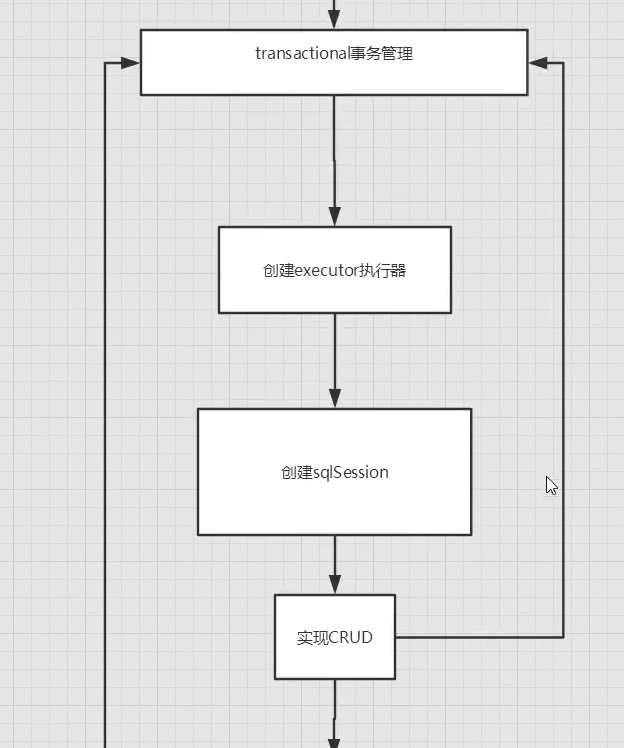
[外链图片转存失败,源站可能有防盗链机制,建议将图片保存下来直接上传(img-cYl1aSip-1688039103992)(https://gitee.com/l_kai916/assets/raw/master/assets/a0dfcdfb4c81e44dd933b5cc26a06889.png)]
8.3、增删改查(CRUD)
我们可以在工具类创建的时候实现自动提交事务!
工具类MybatisUtils
public static SqlSession getSqlSession(){
//设置自动提交事物true
return sqlSessionFactory.openSession(true);
}
增删改查
UserMapper
编写接口增加注解
public interface UserMapper {
@Select("select * from user")
List<User> getUsers();
//方法存在多个参数所有参数前面必须加上@Param("id")注解 一个参数可以不加
//并且只跟@Param("id") 中的参数有关 ,既int id的id可以随便写
@Select("select * from user where id = #{id}")
User getUserByID(@Param("id")int id);
@Insert("insert into user(id,name,pwd) values (#{id},#{name},#{password})")
int addUser(User user);
@Update("update user set name = #{name},pwd = #{password} where id =#{id}")
int modifyUser(User user);
@Delete("delete from user where id = #{id}")
int delUserByID(int id);
}
UserMapperTest
【注意】我们必须将接口绑定注册、[外链图片转存失败,源站可能有防盗链机制,建议将图片保存下来直接上传(img-vBX0jwsN-1688039103993)(https://gitee.com/l_kai916/assets/raw/master/assets/1656751590228.png)]
public class UserMapperTest {
@Test
public void test(){
SqlSession sqlSession = MybatisUtils.getSqlSession();
//底层主要应用反射
UserMapper mapper = sqlSession.getMapper(UserMapper.class);
List<User> users = mapper.getUsers();
for (User user : users) {
System.out.println(user);
}
sqlSession.close();
}
//通过Id查询用户
@Test
public void test02(){
SqlSession sqlSession = MybatisUtils.getSqlSession();
//底层主要应用反射
UserMapper mapper = sqlSession.getMapper(UserMapper.class);
User user = mapper.getUserByID(6);
System.out.println(user);
sqlSession.close();
}
//通过添加用户
@Test
public void test03(){
SqlSession sqlSession = MybatisUtils.getSqlSession();
//底层主要应用反射
UserMapper mapper = sqlSession.getMapper(UserMapper.class);
int user = mapper.addUser(new User(5,"邱龙","sdadas"));
System.out.println(user);
sqlSession.close();
}
//通过修改用户
@Test
public void test04(){
SqlSession sqlSession = MybatisUtils.getSqlSession();
//底层主要应用反射
UserMapper mapper = sqlSession.getMapper(UserMapper.class);
int user = mapper.modifyUser(new User(5,"Dragon","******"));
System.out.println(user);
sqlSession.close();
}
//删除用户
@Test
public void test05(){
SqlSession sqlSession = MybatisUtils.getSqlSession();
//底层主要应用反射
UserMapper mapper = sqlSession.getMapper(UserMapper.class);
int user = mapper.delUserByID(5);
System.out.println(user);
sqlSession.close();
}
}
8.4、关于@Param()注解
- 基本类型的参数或者String类型,需要加上
- 引用类型不需要加
- 如果只有一个基本类型的话,可以忽略,但是建议大家都加上!
- 我们在SQL中引用的就是我们这里的@Param()中设定的属性名!
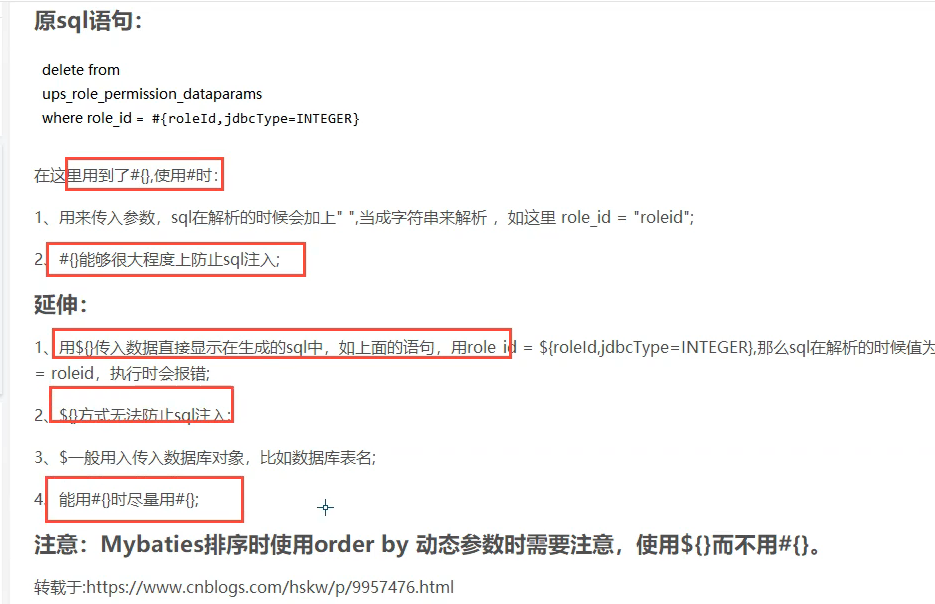
9、Lombok
9.1、Lombok的简介
Lombok:是一款Java开发插件,使得Java开发者可以通过其定义的一些注解来消除业务工程中冗长和繁琐的代码,尤其对于简单的Java模型对象(POJO)。在开发环境中使用Lombok插件后,Java开发人员可以节省重复构建,诸如hashCode和equals这样的方法以及各种业务对象模型的accessor和ToString等方法的大量时间。对于这些方法,它能够在编译源代码期间自动帮我们生成这些方法,并没有如反射那样降低程序的性能。9.2、使用步骤:
9.2、使用步骤:
1.在IDEA中安装Lomboki插件!
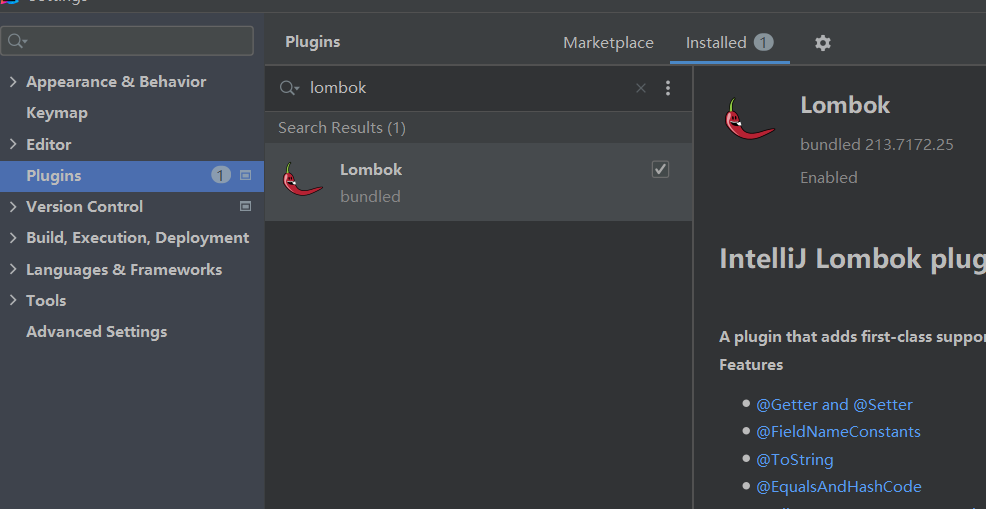
2.在项目中导入lombok的jar包
<!-- https://mvnrepository.com/artifact/org.projectlombok/lombok -->
<dependency>
<groupId>org.projectlombok</groupId>
<artifactId>lombok</artifactId>
<version>1.18.24</version>
</dependency>
3.实体类上加注解
@Getter and @Setter
@FieldNameConstants
@Tostring
@Equal sAndHashCode
@AllArgsconstructor,@Requi redArgsconstructor and @NoArgsconstructor
@Log,@Log4j,@Log4j2,@slf4j,@xs1f4j,@CommonsLog,@JBossLog,@Flogger
@Data
@Builder
@singular
@Delegate
@Value
@Accessors
@wither
@SneakyThrows
@Data:无参构造,get、set、tostring、hashcode,equals
@AllArgsConstructor
@NoArgsConstructor
@EqualsAndHashCode
@ToString
@Getter
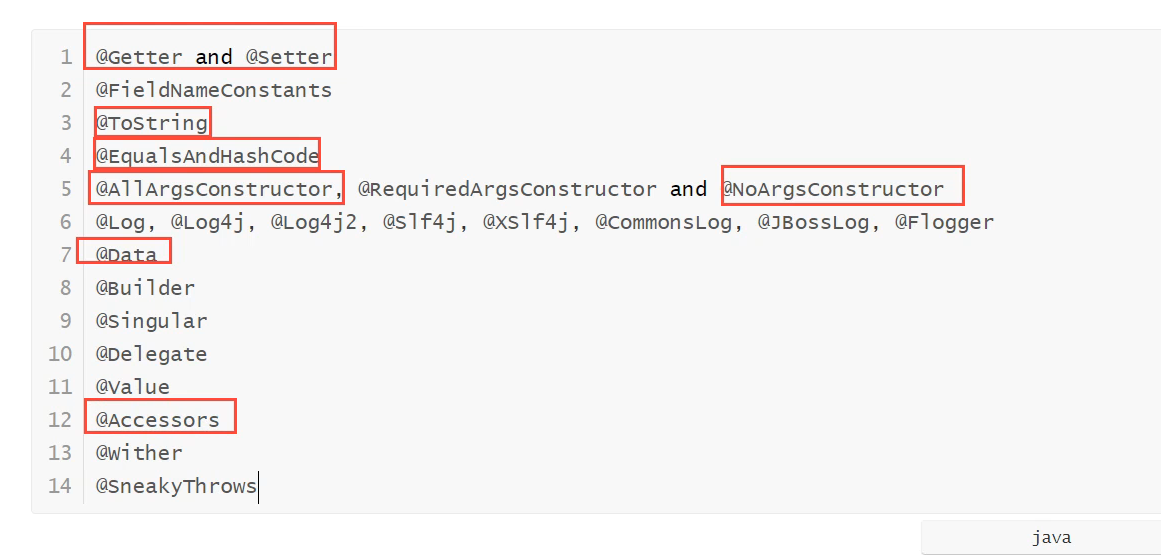
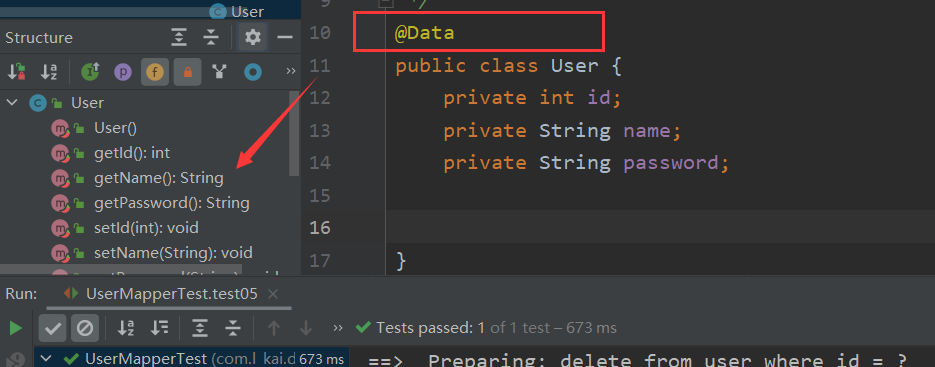

[外链图片转存失败,源站可能有防盗链机制,建议将图片保存下来直接上传(img-5HUJMOUd-1688039103997)(https://gitee.com/l_kai916/assets/raw/master/assets/1656753303245.png)]
10、多对一处理
多对一
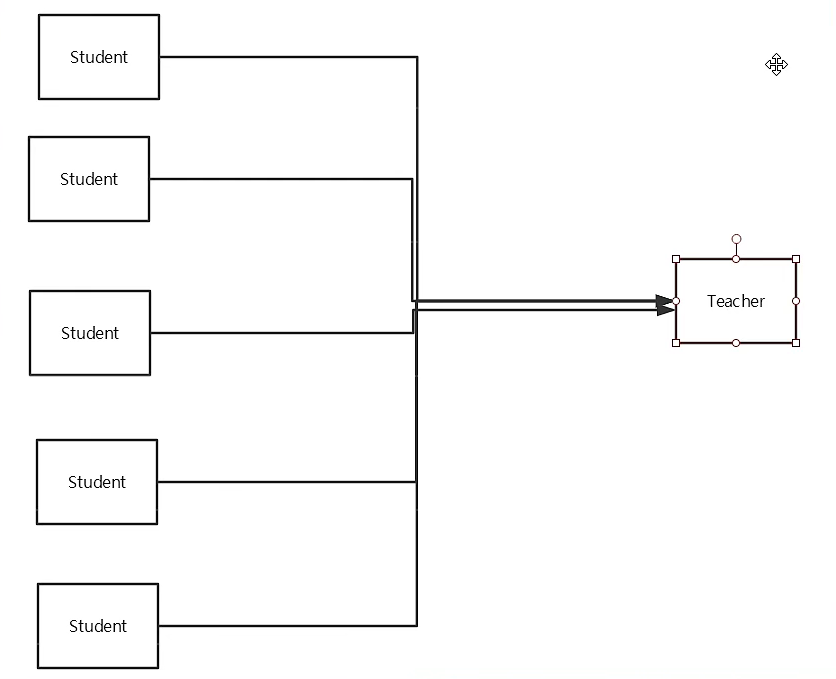
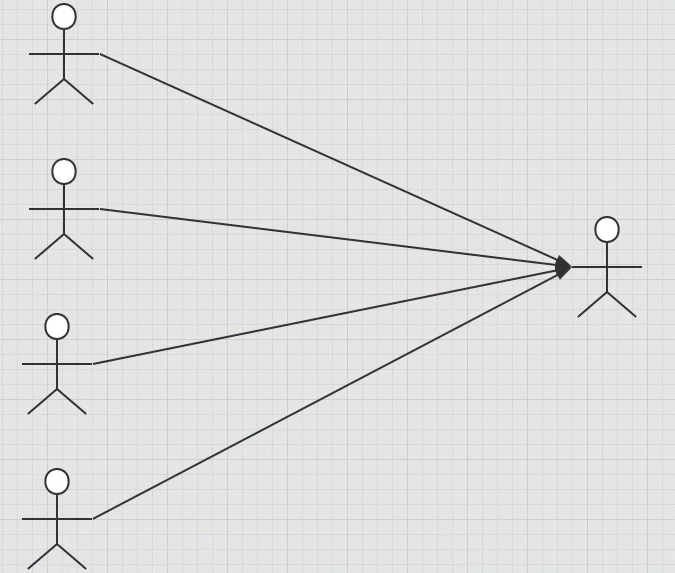
- 多个学生,对应一个老师
- 对于学生这边而言,关联…多个学生,关联一个老师【多对一】
- 对于老师而言,集合,一个老师,有很多学生【一对多】
一会用这两个
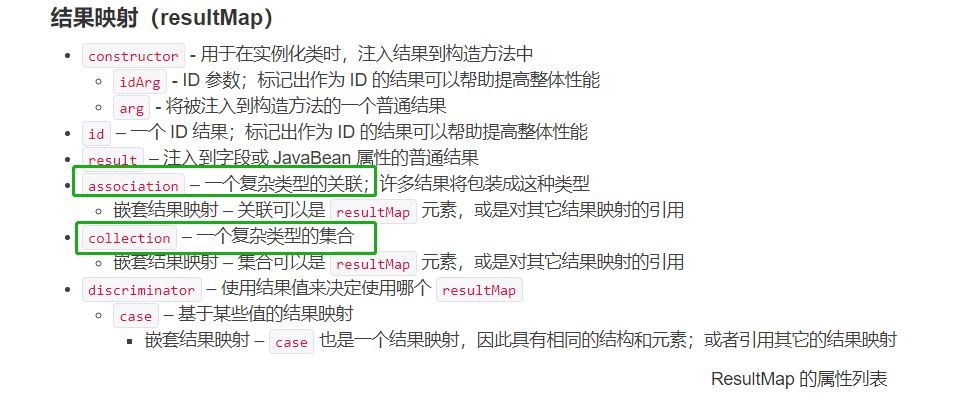
SQL:
CREATE TABLE `teacher` (
`id` INT(10) NOT NULL,
`name` VARCHAR(30) DEFAULT NULL,
PRIMARY KEY (`id`)
) ENGINE=INNODB DEFAULT CHARSET=utf8;
INSERT INTO teacher(`id`, `name`) VALUES (1, '秦老师');
CREATE TABLE `student` (
`id` INT(10) NOT NULL,
`name` VARCHAR(30) DEFAULT NULL,
`tid` INT(10) DEFAULT NULL,
PRIMARY KEY (`id`),
KEY `fktid` (`tid`),
CONSTRAINT `fktid` FOREIGN KEY (`tid`) REFERENCES `teacher` (`id`)
) ENGINE=INNODB DEFAULT CHARSET=utf8;
INSERT INTO `student` (`id`, `name`, `tid`) VALUES ('1', '小明', '1');
INSERT INTO `student` (`id`, `name`, `tid`) VALUES ('2', '小红', '1');
INSERT INTO `student` (`id`, `name`, `tid`) VALUES ('3', '小张', '1');
INSERT INTO `student` (`id`, `name`, `tid`) VALUES ('4', '小李', '1');
INSERT INTO `student` (`id`, `name`, `tid`) VALUES ('5', '小王', '1');
10.1、测试环境搭建
-
导入lombok

<!-- https://mvnrepository.com/artifact/org.projectlombok/lombok --> <dependency> <groupId>org.projectlombok</groupId> <artifactId>lombok</artifactId> <version>1.18.24</version> </dependency> -
新建实体类 Teacher、Student

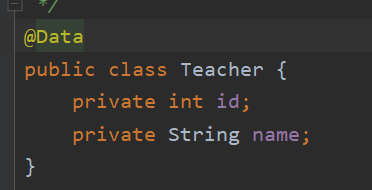
-
建立Mapper接口

-
建立Mapper.xml文件
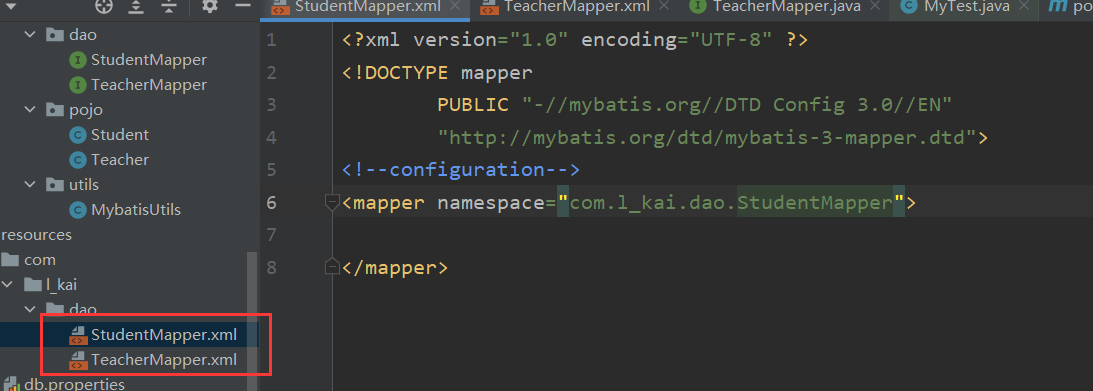
StudentMapper.xml
<?xml version="1.0" encoding="UTF-8" ?> <!DOCTYPE mapper PUBLIC "-//mybatis.org//DTD Config 3.0//EN" "http://mybatis.org/dtd/mybatis-3-mapper.dtd"> <!--configuration--> <mapper namespace="com.l_kai.dao.StudentMapper"> </mapper>Teacher Mapper.xml
<?xml version="1.0" encoding="UTF-8" ?> <!DOCTYPE mapper PUBLIC "-//mybatis.org//DTD Config 3.0//EN" "http://mybatis.org/dtd/mybatis-3-mapper.dtd"> <!--configuration--> <mapper namespace="com.l_kai.dao.TeacherMapper"> </mapper> -
在核心配置文件中绑定注册我们的Mapper接口或者文件!【方式很多】
有class 、resource、package
<mappers> <package name="com.l_kai.dao"/> </mappers> -
测试查询是否能够成功
```java
public class MyTest { @Test public void getTeach(){ SqlSession sqlSession = MybatisUtils.getSqlSession(); TeacherMapper mapper = sqlSession.getMapper(TeacherMapper.class); Teacher teach = mapper.getTeach(1); System.out.println(teach); sqlSession.close(); } }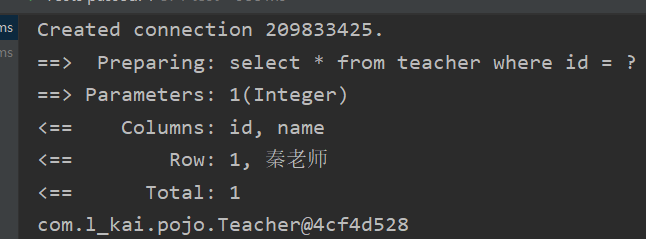
10.2、按照查询嵌套处理
方式一:
<!--
思路:
1.查询所有的学生信息
2.根据查询出来的学生的tid,寻找对应的老师
-->
<resultMap id="StudentTeacher" type="Student">
<result column="id" property="id"/>
<result column="name" property="name"/>
<!--复杂的情况我们要单独处理
对象:association
集合:collection
子查询
-->
<association column="tid" property="teacher" javaType="Teacher" select="getTeacher"/>
</resultMap>
<select id="getStudent" resultMap="StudentTeacher">
select * from student;
</select>
<select id="getTeacher" resultType="Teacher">
select * from teacher where id=#{tid};
</select>
测试
@Test
public void testStudent(){
SqlSession sqlSession = MybatisUtils.getSqlSession();
StudentMapper mapper = sqlSession.getMapper(StudentMapper.class);
List<Student> studentList = mapper.getStudent();
for (Student student : studentList) {
System.out.println(student);
}
sqlSession.close();
}

10.3、按照结果嵌套查询
复杂的属性,我们需要单独处理对象:association集合:collection
StudentMapper.java
<!--按照结果嵌套处理-->
<resultMap id="StudentTeacher2" type="Student">
<result property="id" column="sid"/>
<result property="name" column="sname"/>
<association property="teacher" javaType="Teacher">
<result property="name" column="tname"/>
</association>
</resultMap>
<select id="getStudent2" resultMap="StudentTeacher2">
select s.id sid,s.name sname, t.name tname
from student s ,teacher t
where s.tid = t.id;
</select>
@Test
public void testStudent2(){
SqlSession sqlSession = MybatisUtils.getSqlSession();
StudentMapper mapper = sqlSession.getMapper(StudentMapper.class);
List<Student> studentList = mapper.getStudent2();
for (Student student : studentList) {
System.out.println(student);
}
sqlSession.close();
}
[外链图片转存失败,源站可能有防盗链机制,建议将图片保存下来直接上传(img-lln5x6Uh-1688039104003)(https://gitee.com/l_kai916/assets/raw/master/assets/1656812300201.png)]
回顾Mysql多对一查询方式:
- 子查询
- 联表查询
11、一对多处理
比如:一个老师拥有多个学生!
对于老师而言,就是一对多的关系
1.环境搭建,同前
2.实体类
Student
@Data
public class Student {
private int id;
private String name;
private int tid;
}
Teacher
@Data
public class Teacher {
private int id;
private String name;
//一个老师拥有多个学生
private List<Student> students;
}
11.1、问题:属性名和字段名不一致问题
public interface TeacherMapper {
//获取老师
List<Teacher> getTeacher();
}
<select id="getTeacher" resultType="Teacher">
select * from teacher;
</select>
@Test
public void test(){
SqlSession sqlSession = MybatisUtils.getSqlSession();
TeacherMapper mapper = sqlSession.getMapper(TeacherMapper.class);
List<Teacher> teach = mapper.getTeacher();
for (Teacher teacher : teach) {
System.out.println(teacher);
}
sqlSession.close();
}

解决:
解决方式一:按结果嵌套查询
TeacherMapper 接口实现
public interface TeacherMapper {
//获取指定老师下的所有学生,既老师的信息
Teacher getTeacher(@Param("tid") int id);
}
编写配置文件
TeacherMapper.xml
<!--复杂的情况我们要单独处理
对象:association javaType="" 指定属性的类型
集合:collection 集合中泛型的信息,我们使用ofType获取
子查询
-->
<resultMap id="TeacherStudent" type="Teacher">
<result property="id" column="tid"/>
<result property="name" column="tname"/>
<collection property="students" column="s" ofType="Student">
<result property="id" column="sid"/>
<result property="name" column="sname"/>
<result property="tid" column="tid"/>
</collection>
</resultMap>
<!--按结果嵌套查询-->
<select id="getTeacher" resultMap="TeacherStudent">
select s.id sid,s.name sname,t.name tname,t.id tid
from student s,teacher t
where s.tid =t.id and t.id=#{tid};
</select>
测试
@Test
public void test(){
SqlSession sqlSession = MybatisUtils.getSqlSession();
TeacherMapper mapper = sqlSession.getMapper(TeacherMapper.class);
Teacher teacher = mapper.getTeacher(1);
System.out.println(teacher);
/*
Teacher(
id=1,
name=罗老师,
students=[Student(id=1, name=小明, tid=1), Student(id=3, name=小张, tid=1), Student(id=4, name=小李, tid=1), Student(id=5, name=小王, tid=1)])
*/
sqlSession.close();
}
[外链图片转存失败,源站可能有防盗链机制,建议将图片保存下来直接上传(img-brr0fNNp-1688039104005)(https://gitee.com/l_kai916/assets/raw/master/assets/1656815598966.png)]
解决方式二:按照查询嵌套处理
接口实现
getTeacher2
public interface TeacherMapper {
//获取指定老师下的所有学生,既老师的信息
Teacher getTeacher(@Param("tid") int id);
//子查询
Teacher getTeacher2(@Param("tid") int id);
}
配置文件
TeacherMapper.xml
<select id="getTeacher2" resultMap="TeacherStudent2">
select * from mybatis.teacher where id = #{tid}
</select>
<select id="getStudentByTeacherId" resultType="Student">
select * from mybatis.student where tid = #{tid}
</select>
<resultMap id="TeacherStudent2" type="Teacher">
<result property="id" column="id"/>
<result property="name" column="name"/>
<!--java类型是集合ArrayList 泛型的信息是 -->
<collection property="students" column="id" javaType="ArrayList" ofType="Student" select="getStudentByTeacherId">
<result property="id" column="tid"/>
</collection>
</resultMap>
测试
@Test
public void test02(){
SqlSession sqlSession = MybatisUtils.getSqlSession();
TeacherMapper mapper = sqlSession.getMapper(TeacherMapper.class);
Teacher teacher= mapper.getTeacher2(1);
System.out.println(teacher);
sqlSession.close();
}
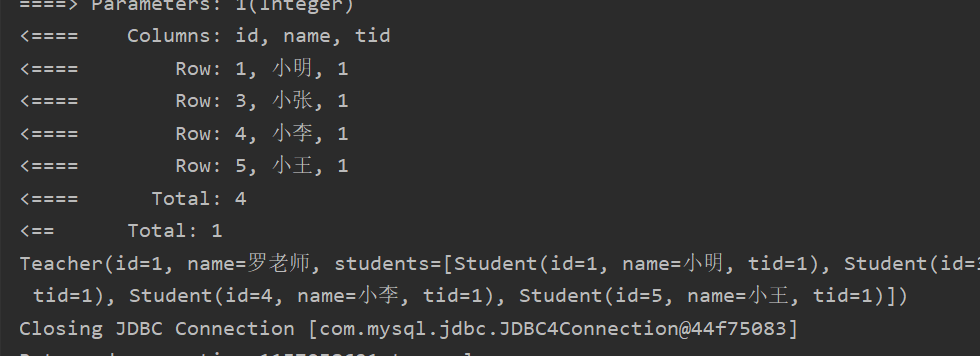
小结
- 关联-association【多对一】
- 集合-collection【一对多】
javaType&ofTypeJavaType用来指定实体类中属性的类型ofType用来指定映射到List或者集合中的pojo类型,泛型中的约束类型!
注意点:
- 保证SQL的可读性,尽量保证通俗易懂
- 注意一对多和多对一中,属性名和字段的问题!
- 如果问题不好排查错误,可以使用日志,建议使用Log4j
慢SQL 1s 1000s
面试高频
- Mysql引擎
- InnoDB底层原理
- 索引
- 索引优化!
12、动态SQL
什么是动态SQL:动态SQL就是指根据不同的条件生成不同的SQL语句
利用动态SQL这一特性可以彻底摆脱这种痛苦。
如果你之前用过 JSTL 或任何基于类 XML 语言的文本处理器,你对动态 SQL 元素可能会感觉似曾相识。在 MyBatis 之前的版本中,需要花时间了解大量的元素。借助功能强大的基于 OGNL 的表达式,MyBatis 3 替换了之前的大部分元素,大大精简了元素种类,现在要学习的元素种类比原来的一半还要少。
if
choose (when, otherwise)
trim (where, set)
foreach
12.1、搭建环境
SQL语句
CREATE TABLE `blog`(
`id` VARCHAR(50) NOT NULL COMMENT '博客id',
`title` VARCHAR(100) NOT NULL COMMENT '博客标题',
`author` VARCHAR(30) NOT NULL COMMENT '博客作者',
`create_time` DATETIME NOT NULL COMMENT '创建时间',
`views` INT(30) NOT NULL COMMENT '浏览量'
)ENGINE=INNODB DEFAULT CHARSET=utf8
创建一个基础工程
-
导包
-
编写配置文件
-
编写实体类
@Data public class Blog { private String id; private String title; private String author; private Date createTime;//属性名和字段名不一致 private int views; } -
编写实体类对应Mapper接口和Mapper.XML文件
BlogMapper
public interface BlogMapper { //插入数据 int addBlog(Blog blog); }BlogMapper.xml
<?xml version="1.0" encoding="UTF-8" ?> <!DOCTYPE mapper PUBLIC "-//mybatis.org//DTD Config 3.0//EN" "http://mybatis.org/dtd/mybatis-3-mapper.dtd"> <!--configuration--> <mapper namespace="com.l_kai.dao.BlogMapper"> <insert id="addBlog" parameterType="Blog"> insert into mybatis.blog (id,title,author,create_time,views) values(#{id},#{title},#{author},#{createTime},#{views}) </insert> </mapper>
注册 方式多
<mappers>
<package name="com.l_kai.dao"/>
</mappers>
新添加一个工具类(可以在插入时随机生成id时 生成通用唯一标识符)
IDutils.java
public class IDUtils {
public static String getId(){
//UUID 通用唯一标识符
return UUID.randomUUID().toString().replaceAll("-","");
}
@Test
public void test(){
System.out.println(IDUtils.getId());
System.out.println(IDUtils.getId());
System.out.println(IDUtils.getId());
}
}
前面实体类中的createTime属性和表中字段create_time不对应
但是可以通过开启驼峰命名规则来应对,也只有这个可以通过配置文件setting来对应.
mybatis-3-config
<!--是否开启驼峰命名规则 CamelCase 映射-->
<setting name="mapUnderscoreToCamelCase" value="true"/>
MyTest 测试插入数据
public class Mytest {
@Test
public void addBlogTest() {
SqlSession sqlSession = MybatisUtils.getSqlSession();
BlogMapper mapper = sqlSession.getMapper(BlogMapper.class);
Blog blog = new Blog();
blog.setId(IDUtils.getId());
blog.setTitle("Mybatis");
blog.setAuthor("狂神说");
blog.setCreateTime(new Date());
blog.setViews(9999);
mapper.addBlog(blog);
blog.setId(IDUtils.getId());
blog.setTitle("Java");
mapper.addBlog(blog);
blog.setId(IDUtils.getId());
blog.setTitle("Spring");
mapper.addBlog(blog);
blog.setId(IDUtils.getId());
blog.setTitle("微服务");
mapper.addBlog(blog);
sqlSession.close();
}
}
插入成功
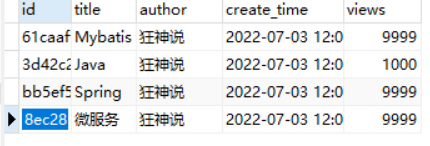
12.2、IF
BlogMapper.java
public interface BlogMapper {
//插入数据
int addBlog(Blog blog);
//查询博客
List<Blog> queryBlogIF(Map map);
}
BlogMapper.xml
<!--动态SQL-->
<select id="queryBlogIF" parameterType="map" resultType="Blog">
select * from mybatis.blog where 1 = 1
<if test="title!= null">
and title = #{title}
</if>
<if test="author!= null">
and author = #{author}
</if>
</select>
测试
@Test
public void queryBlogIF(){
SqlSession sqlSession = MybatisUtils.getSqlSession();
BlogMapper mapper = sqlSession.getMapper(BlogMapper.class);
HashMap map = new HashMap();
map.put("author","狂神说");//可以 不传参也可以查出所有,可以限定参数查找
List<Blog> blogs = mapper.queryBlogIF(map);
for (Blog blog : blogs) {
System.out.println(blog);
}
sqlSession.close();
}

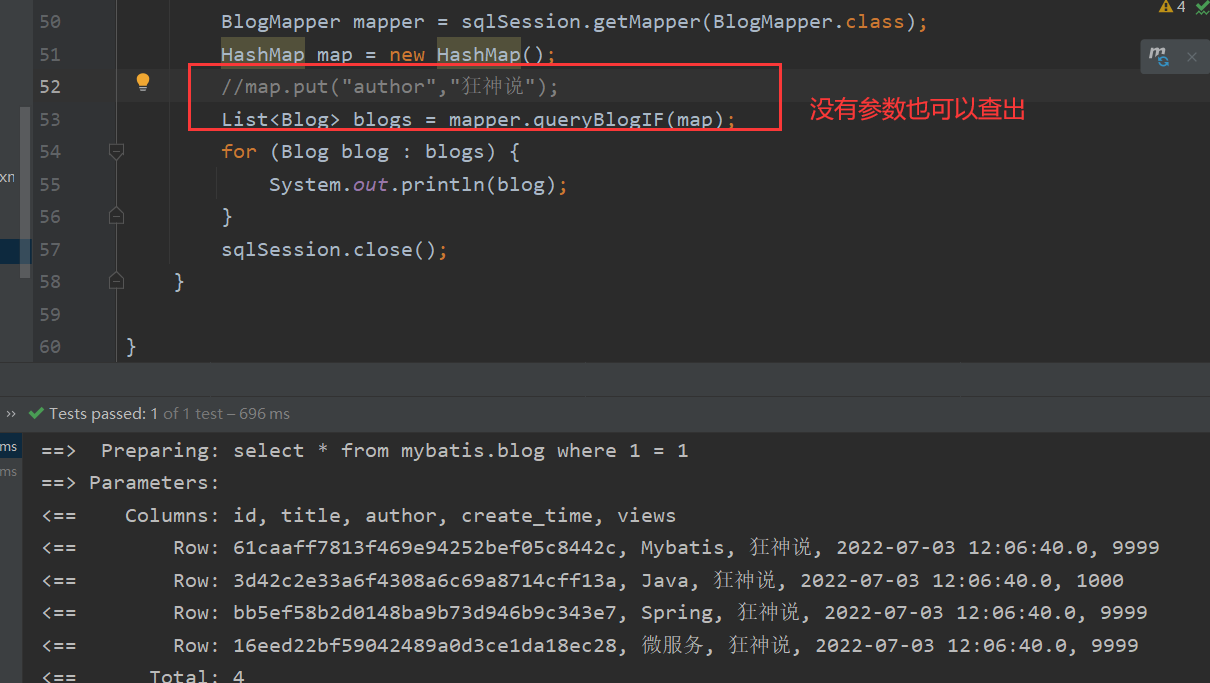
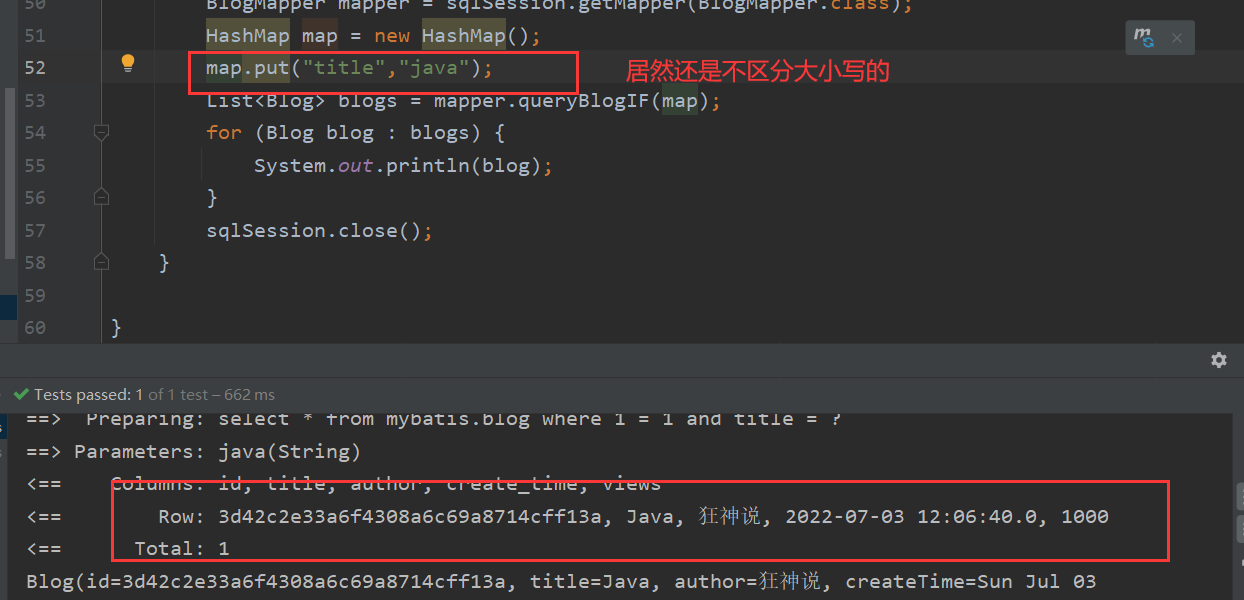
12.3、choose (when,otherwise)
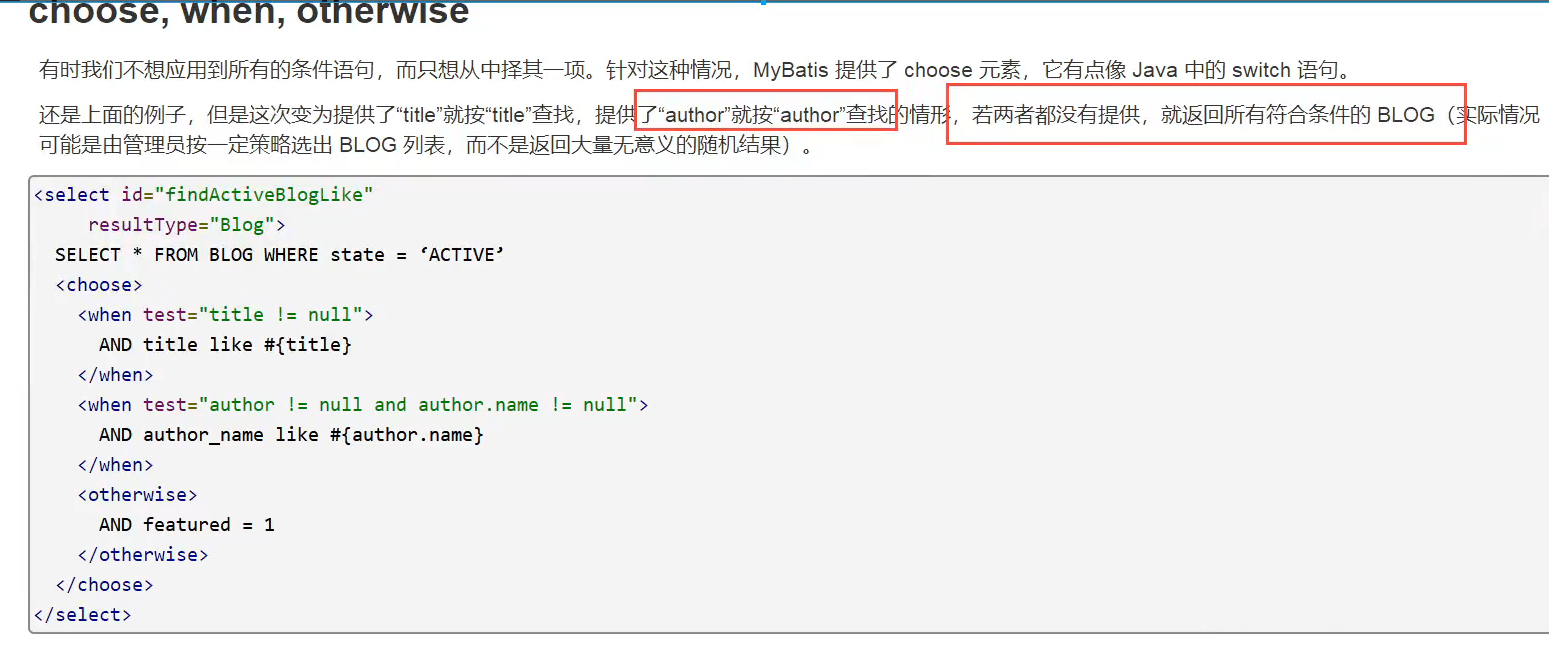
choose只拼接满足条件的一个
<select id="queryBlogChoose" parameterType="map" resultType="blog">
select * from mybatis.blog
<where>
<choose>
<when test="title != null">
title = #{title}
</when>
<when test="author !=null">
and author = #{author}
</when>
<otherwise>
and views = #{views}
</otherwise>
</choose>
</where>
</select>
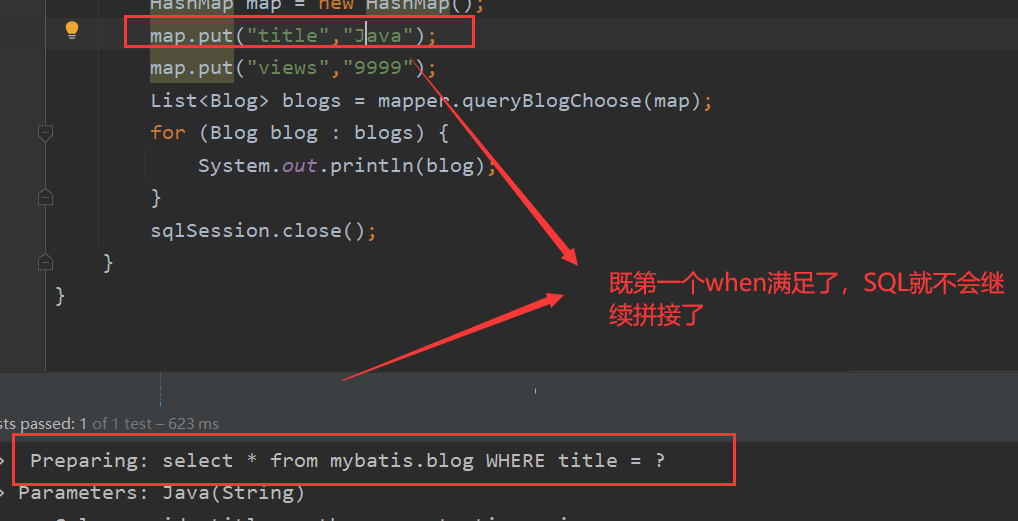
12.4、trim(where,set)
1.where标签
之前12.2中也存在问题 既 一般项目中不会在sql语句后 加上 1 = 1 ,因为不安全。
where标签
1. 什么都不传会去掉where
2. *where* 元素只会在子元素返回任何内容的情况下才插入 “WHERE” 子句。
3. 若子句的开头为 “AND” 或 “OR”,*where* 元素也会将它们去除
[外链图片转存失败,源站可能有防盗链机制,建议将图片保存下来直接上传(img-m5nNQTCB-1688039104011)(https://gitee.com/l_kai916/assets/raw/master/assets/1656834888470.png)]
[外链图片转存失败,源站可能有防盗链机制,建议将图片保存下来直接上传(img-Wkmp4QBy-1688039104012)(https://gitee.com/l_kai916/assets/raw/master/assets/1656834707774.png)]
<select id="queryBlogIF" parameterType="map" resultType="blog">
select * from mybatis.blog
<where>
<if test="title != null">
and title = #{title}
</if>
<if test="author != null">
and author = #{author}
</if>
</where>
</select>
2.set标签
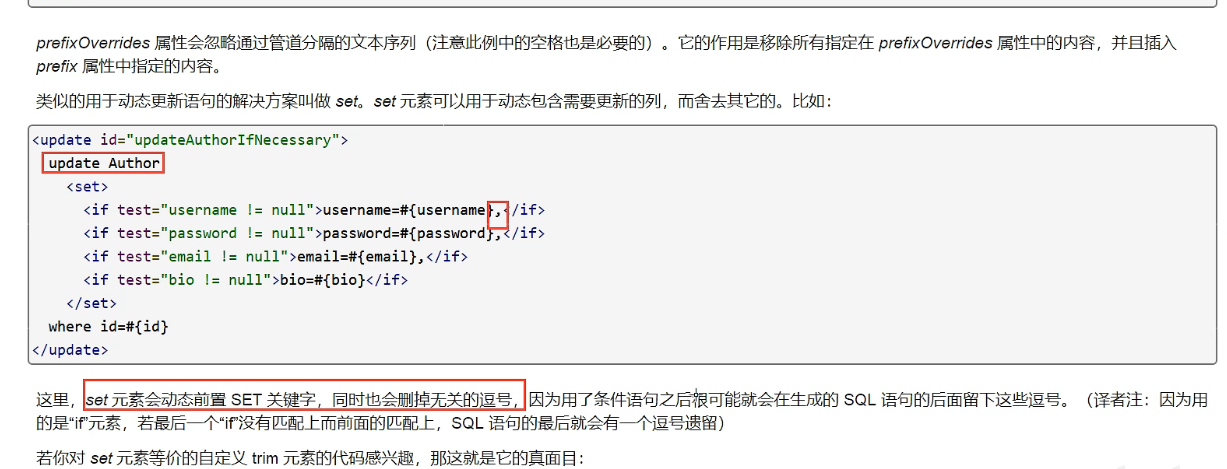
public interface BlogMapper {
//插入数据
int addBlog(Blog blog);
//查询博客
List<Blog> queryBlogIF(Map map);
List<Blog> queryBlogChoose(Map map);
//更新博客
int updateBlog(Map map);
}
<update id="updateBlog" parameterType="map">
update mybatis.blog
<set>
<if test="title != null">
title = #{title},
</if>
<if test="author != null">
author = #{author}
</if>
</set>
where id = #{id}
</update>
测试
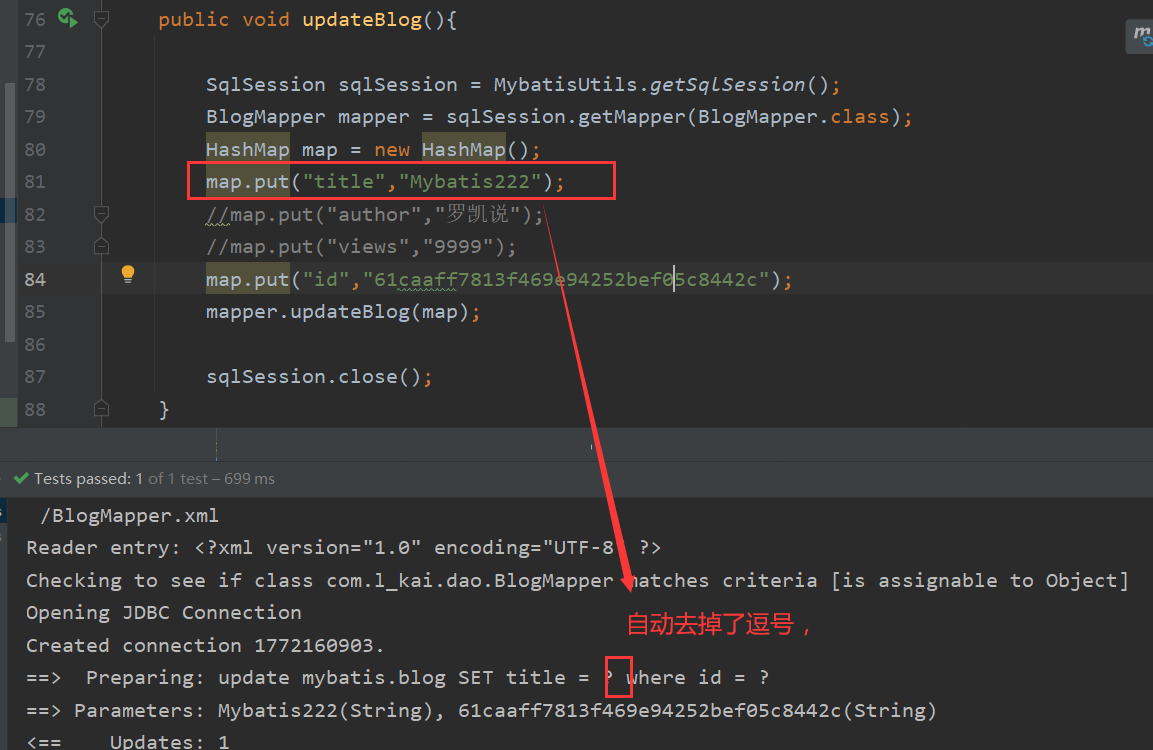
12.5、SQL片段
有的时候,我们可能会将一些功能的部分抽取出来,方便复用!
-
使用SQL标签抽取公共的部分
<!--sql片段--> <sql id="if-title-author"> <if test="title!= null"> and title = #{title} </if> <if test="author!= null"> and author = #{author} </if> </sql> <!--动态SQL--> <select id="queryBlogIF" parameterType="map" resultType="Blog"> select * from mybatis.blog <where> <include refid="if-title-author"></include> </where> </select> -
在需要使用的地方使用Include标签引用即可
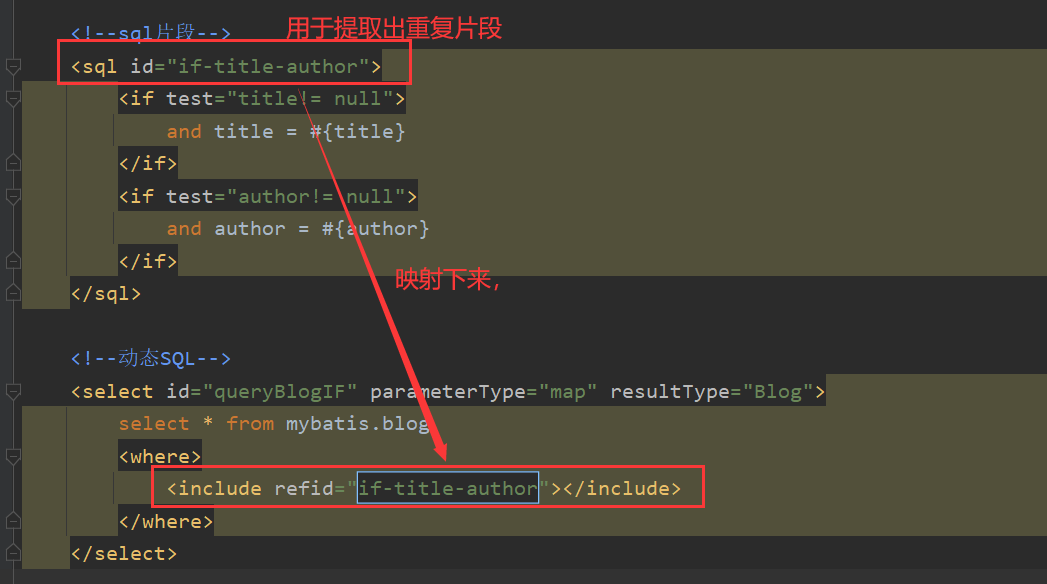
[外链图片转存失败,源站可能有防盗链机制,建议将图片保存下来直接上传(img-kNAAoWBM-1688039104015)(https://gitee.com/l_kai916/assets/raw/master/assets/1656898093064.png)]
-
最好基于单表来定义SQL片段!
-
不要存在where标签
12.6、Foreach
select from user where 1=1 and
<foreach item="id" index="index" collection="ids"
open="ID in (" separator="," close=")">
#{id}
</foreach>
(id=1 or id=2 or id=3)

BlogMapper
public interface BlogMapper {
//插入数据
int addBlog(Blog blog);
//查询博客
List<Blog> queryBlogIF(Map map);
List<Blog> queryBlogChoose(Map map);
//更新博客
int updateBlog(Map map);
//查询第1-2-3号记录的博客
List<Blog> queryBlogForeach(Map map);
}
BlogMapper.xml
<!--foreach,遍历集合-->
<select id="queryBlogForeach" parameterType="map" resultType="Blog">
select * from mybatis.blog
<where>
<foreach collection="ids" item="id" open="and (" close=")" separator="or">
id = #{id}
</foreach>
</where>
</select>
测试
public void queryBlogForeach(){
SqlSession sqlSession = MybatisUtils.getSqlSession();
BlogMapper mapper = sqlSession.getMapper(BlogMapper.class);
HashMap map = new HashMap();
ArrayList<Integer> ids = new ArrayList<>();
ids.add(1);
ids.add(2);
ids.add(3);
map.put("ids",ids);
List<Blog> blogs = mapper.queryBlogForeach(map);
for (Blog blog : blogs) {
System.out.println(blog);
}
sqlSession.close();
}
[外链图片转存失败,源站可能有防盗链机制,建议将图片保存下来直接上传(img-fhPl8XUv-1688039104016)(https://gitee.com/l_kai916/assets/raw/master/assets/1656900298209.png)]
动态SQL就是在拼接SQL语句,我们只要保证SQL的正确性,按照SQL的格式,去排列组合就可以了
建议:
- 先在Mysql中写出完整的SQL,再对应的去修改成为我们的动态SQL实现通用即可!
13、缓存
13.1、简介
查询 : 连接数据库,耗资源!
一次查询的结果,给他暂存在一个可以直接取到的地方!-->内存:缓存
我们再次查询相同数据的时候,直接走缓存,就不用走数据库了
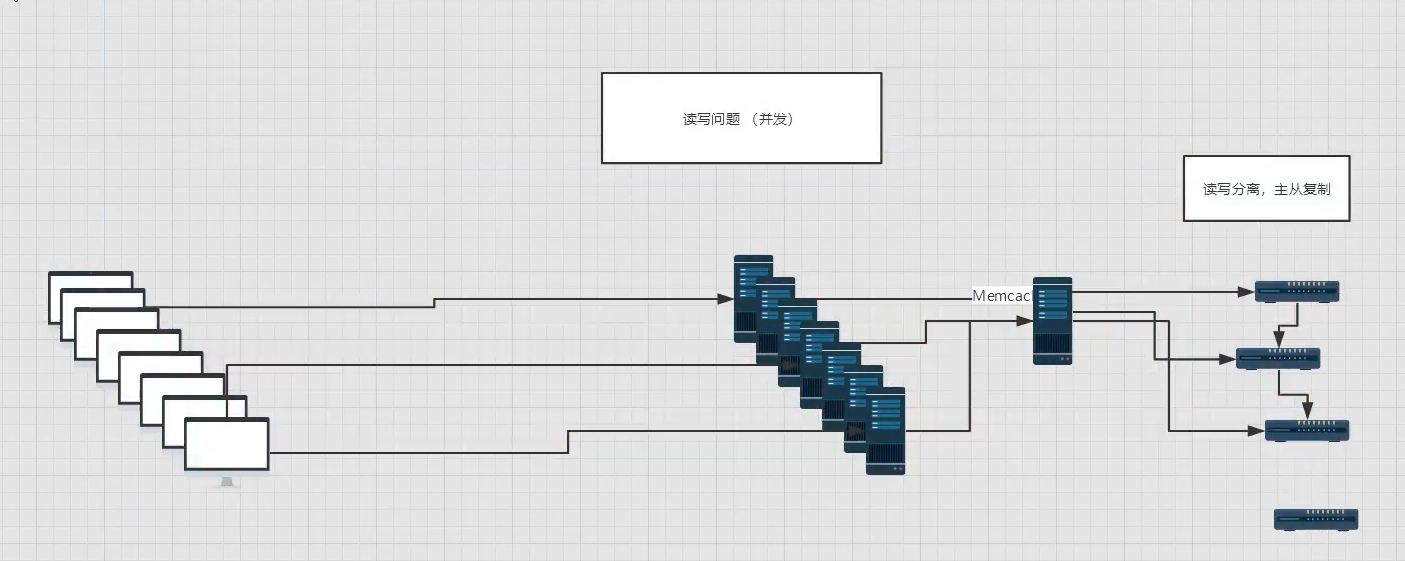
1.什么是缓存[Cache]?
- 存在内存中的临时数据。
- 将用户经常查询的数据放在缓存(内存)中,用户去查询数据就不用从磁盘上(关系型数据库数据文件)查询,从缓存中查询,从而提高查询效率,解决了高并发系统的性能问题。
2.为什么使用缓存?
- 减少和数据库的交互次数,减少系统开销,提高系统效率。
3.什么样的数据能使用缓存?
- 经常查询并且不经常改变的数据。
13.2、Mybatis:缓存
MyBatis包含一个非常强大的查询缓存特性,它可以非常方便地定制和配置缓存。缓存可以极大的提升查询效率
MyBatis系统中默认定义了两级缓存:一级缓存和二级缓存
-
默认情况下,只有一级缓存开启。(SqlSession级别的缓存,也称为本地缓存)
-
二级缓存需要手动开启和配置,他是基于namespace级别的缓存。
-
为了提高扩展性,MyBatis定义了缓存接口Cache。我们可以通过实现Cache接口来自定义二级缓存
[外链图片转存失败,源站可能有防盗链机制,建议将图片保存下来直接上传(img-hlo9uidT-1688039104017)(https://gitee.com/l_kai916/assets/raw/master/assets/0211bf9626ac8a9ae909e7552c33f236.png)]
13.3、一级缓存
一级缓存也叫本地缓存:SqlSession
- 与数据库同一次会话期间查询到的数据会放在本地缓存中。
- 以后如果需要获取相同的数据,直接从缓存中拿,没必须再去查询数据库;
测试步骤:
-
开启日志!
-
测试在一个Sesion中查询两次相同记录
-
查看日志输出
[外链图片转存失败,源站可能有防盗链机制,建议将图片保存下来直接上传(img-ggsIh883-1688039104018)(https://gitee.com/l_kai916/assets/raw/master/assets/1656902609898.png)]
[外链图片转存失败,源站可能有防盗链机制,建议将图片保存下来直接上传(img-qXVBsZz0-1688039104018)(https://gitee.com/l_kai916/assets/raw/master/assets/1656902624573.png)]
[外链图片转存失败,源站可能有防盗链机制,建议将图片保存下来直接上传(img-ZFgFlMW6-1688039104019)(https://gitee.com/l_kai916/assets/raw/master/assets/1656902650462.png)]

增删改都会清除缓存
如修改
[外链图片转存失败,源站可能有防盗链机制,建议将图片保存下来直接上传(img-ConImqg6-1688039104020)(https://gitee.com/l_kai916/assets/raw/master/assets/1656903517379.png)]
[外链图片转存失败,源站可能有防盗链机制,建议将图片保存下来直接上传(img-k1GETi0b-1688039104021)(https://gitee.com/l_kai916/assets/raw/master/assets/1656903525907.png)]
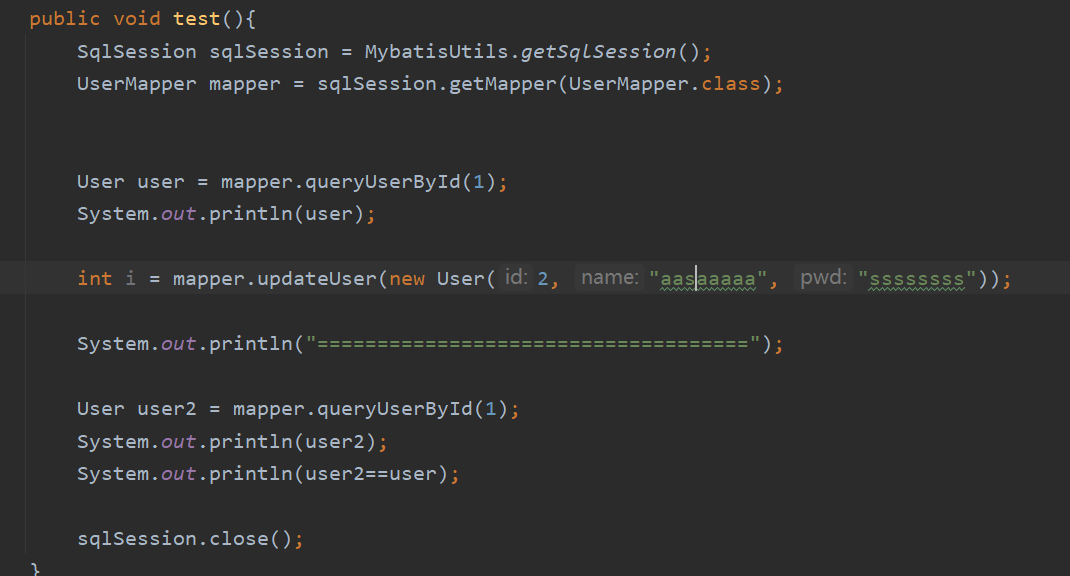

缓存失效的情况:
-
查询不同的东西
-
增删改操作,可能会改变原来的数据,所以必定会刷新缓存!
-
查询不同的Mapper.xml
-
手动清理缓存! clearCache()

小结:
一级缓存默认是开启的,只在一次SqlSession中有效,也就是拿到连接到关闭连接这个区间段!
一级缓存就是一个Map。
13.4、二级缓存
二级缓存也叫全局缓存,一级缓存作用域太低了,所以诞生了二级缓存
基于namespace级别的缓存,一个名称空间,对应一个二级缓存;
工作机制
- 一个会话查询一条数据,这个数据就会被放在当前会话的一级缓存中;
- 如果当前会话关闭了,这个会话对应的一级缓存就没了;但是我们想要的是,会话关闭了,一级缓存中的数据被保存到二级缓存中;
- 新的会话查询信息,就可以从二级缓存中获取内容:
- 不同的mapper查出的数据会放在自己对应的缓存(map)中;
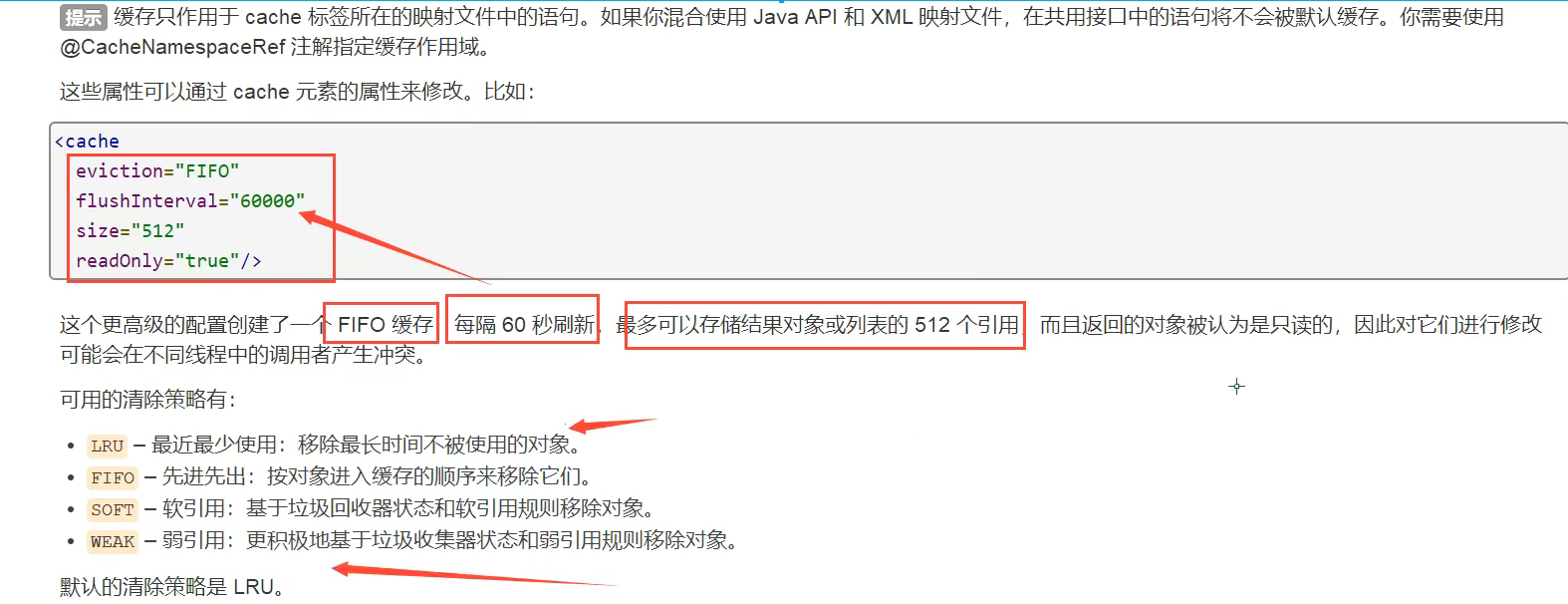
步骤:
- 开启全局缓存
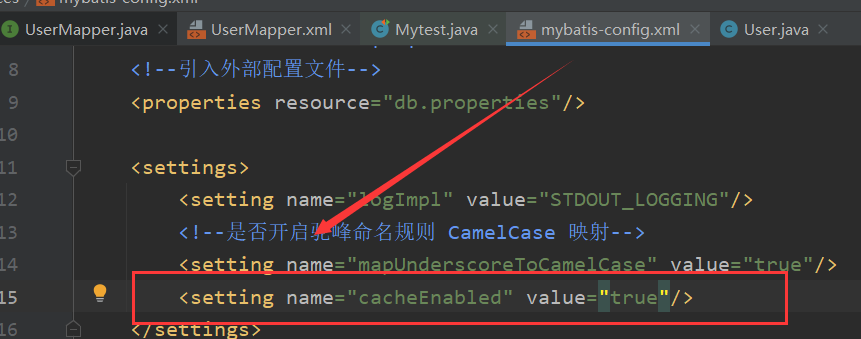
<!--显示的开启全局缓存-->
<setting name="cacheEnabled" value="true"/>
-
在要使用二级缓存的Mapper中开启
<!-- 在当前文件Mapper.xml文件开启二级缓存--> <cache/>
也可以自定义参数
<!--在当前Mapper.xml文件中开启二级缓存-->
<cache eviction="FIFO"
flushInterval="60000"
size="512"
readOnly="true"/>
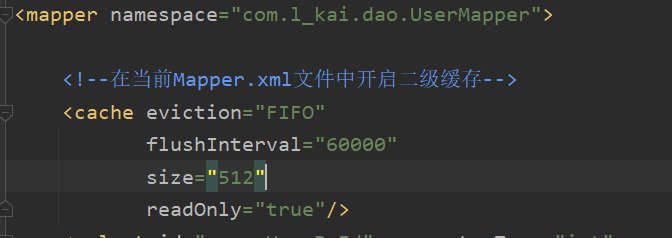
测试
@Test
public void test(){
SqlSession sqlSession = MybatisUtils.getSqlSession();
SqlSession sqlSession2 = MybatisUtils.getSqlSession();
UserMapper mapper = sqlSession.getMapper(UserMapper.class);
UserMapper mapper2 = sqlSession2.getMapper(UserMapper.class);
User user = mapper.queryUserById(1);
System.out.println(user);
sqlSession.close();
//mapper.updateUser(new User(2, "aasaaaaa", "ssssssss"));
//sqlSession.clearCache();//手动清理缓存
System.out.println("====================================");
User user2 = mapper2.queryUserById(1);
System.out.println(user2);
System.out.println(user2==user);
sqlSession2.close();
}
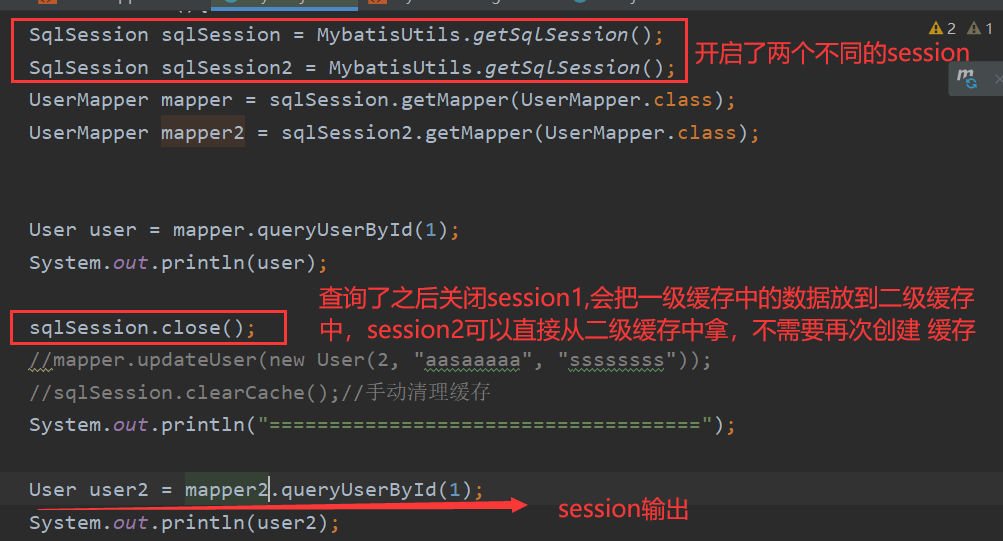
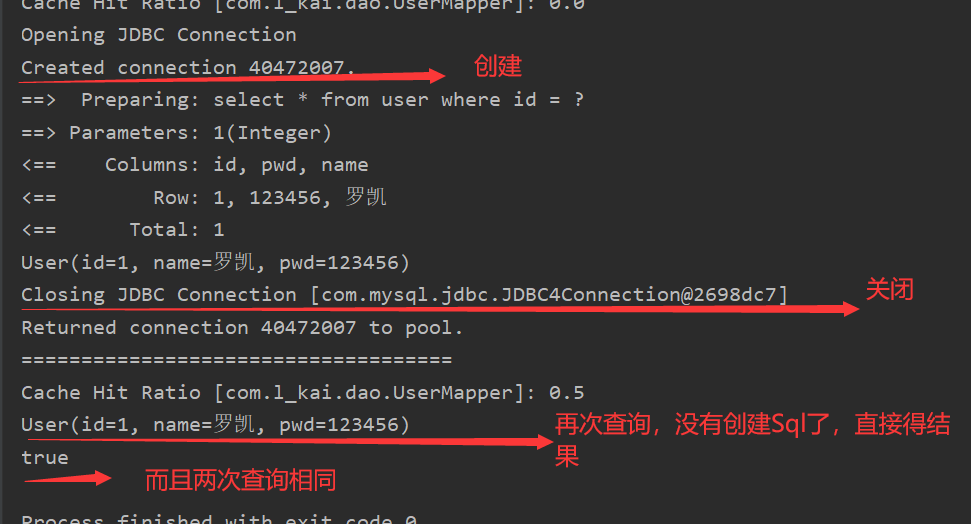
3.如果仅用 ,而不添加参数得话,需要把实体类序列化,序列化的处理是为了方便在二级缓存中查找会报错
<cache/>

解决:
序列化以后都可加上
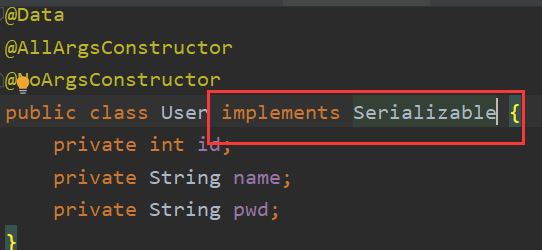
更改之后
因为可读写得缓存会(通过序列化)返回缓存对象的拷贝,所以不是一个对象了
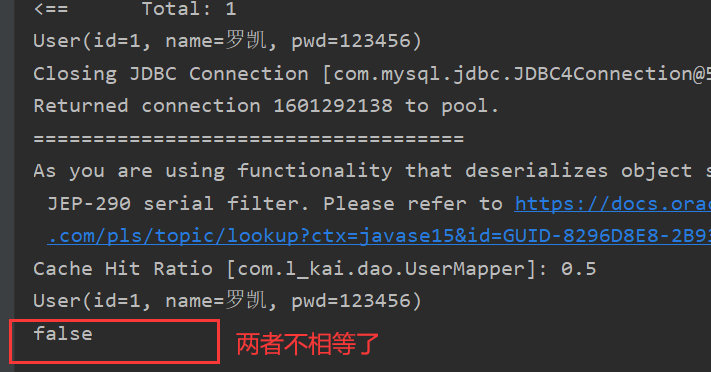
开启只读 则为同一个对象

13.5、缓存原理
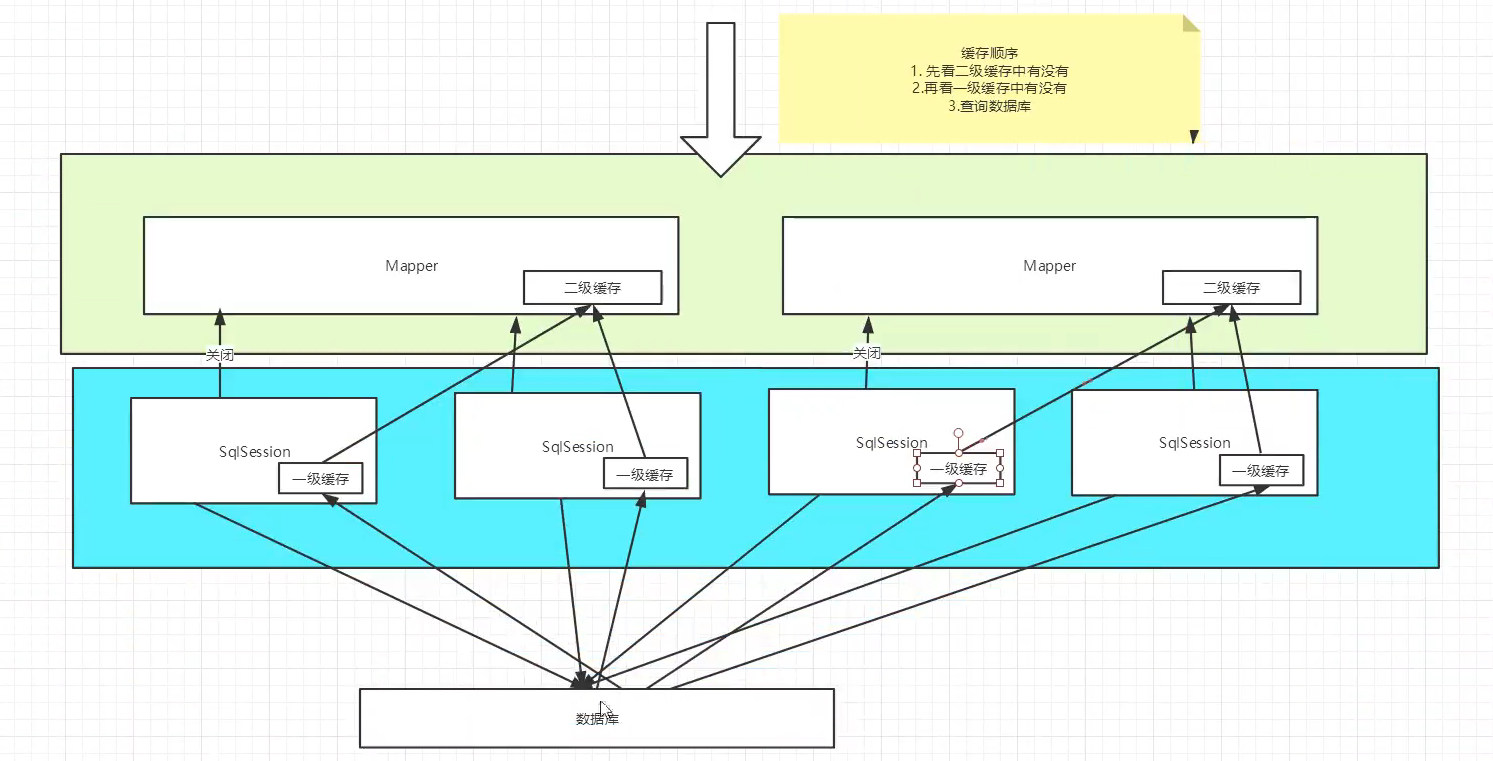
13.6、自定义缓存-ehcache
Ehcache是一种广泛使用的开源]ava分布式缓存。主要面向通用缓存
要在程序中使用ehcache,先要导包!

<!-- https://mvnrepository.com/artifact/org.mybatis.caches/mybatis-ehcache -->
<dependency>
<groupId>org.mybatis.caches</groupId>
<artifactId>mybatis-ehcache</artifactId>
<version>1.1.0</version>
</dependency>
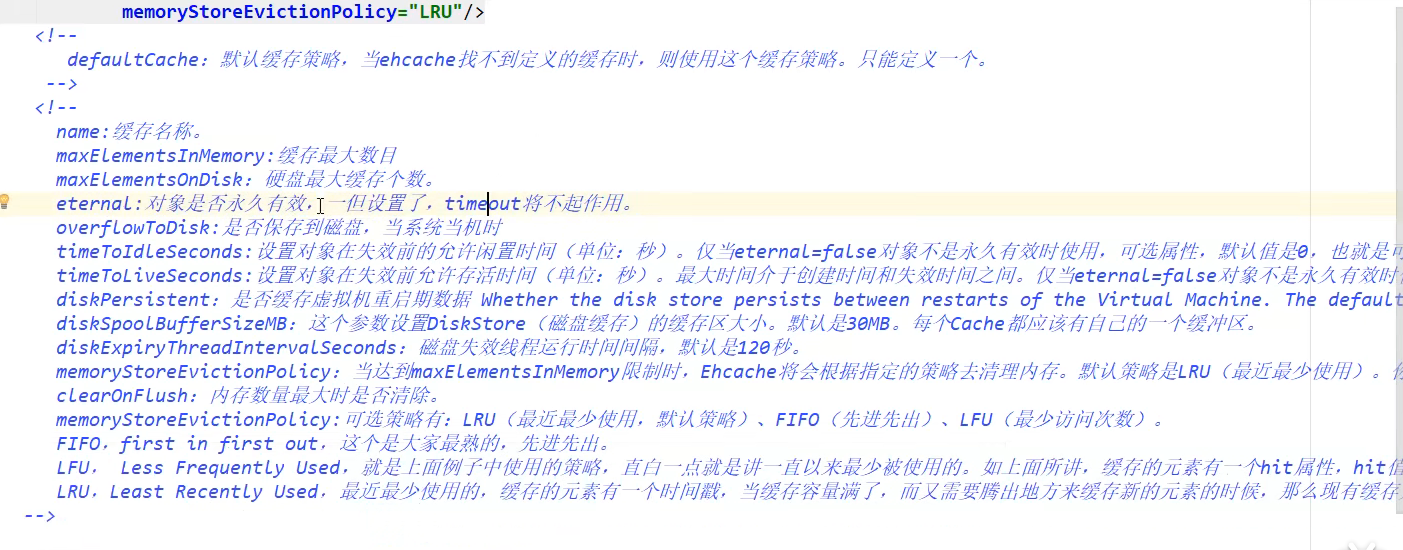
Mapper.xml指定缓存
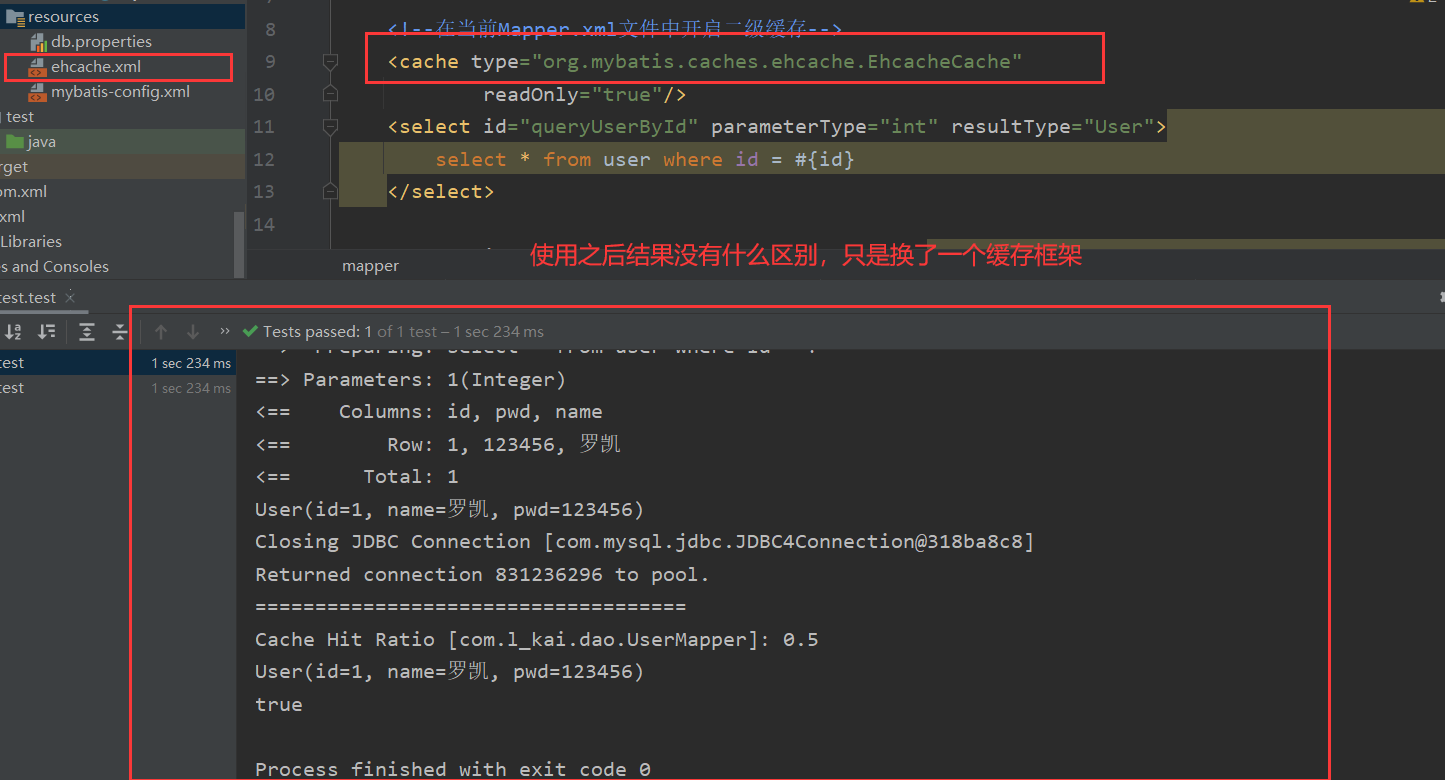
小结:
一级缓存默认是开启的,只在一次SqlSession中有效,也就是拿到连接到关闭连接这个区间段!
一级缓存就是一个Map。
13.4、二级缓存
二级缓存也叫全局缓存,一级缓存作用域太低了,所以诞生了二级缓存
基于namespace级别的缓存,一个名称空间,对应一个二级缓存;
工作机制
- 一个会话查询一条数据,这个数据就会被放在当前会话的一级缓存中;
- 如果当前会话关闭了,这个会话对应的一级缓存就没了;但是我们想要的是,会话关闭了,一级缓存中的数据被保存到二级缓存中;
- 新的会话查询信息,就可以从二级缓存中获取内容:
- 不同的mapper查出的数据会放在自己对应的缓存(map)中;
[外链图片转存中…(img-wUOTvdW9-1688039104023)]
步骤:
- 开启全局缓存
[外链图片转存中…(img-mpEArtEl-1688039104023)]
<!--显示的开启全局缓存-->
<setting name="cacheEnabled" value="true"/>
-
在要使用二级缓存的Mapper中开启
<!-- 在当前文件Mapper.xml文件开启二级缓存--> <cache/>
也可以自定义参数
<!--在当前Mapper.xml文件中开启二级缓存-->
<cache eviction="FIFO"
flushInterval="60000"
size="512"
readOnly="true"/>
[外链图片转存中…(img-SUCDwgLW-1688039104024)]
测试
@Test
public void test(){
SqlSession sqlSession = MybatisUtils.getSqlSession();
SqlSession sqlSession2 = MybatisUtils.getSqlSession();
UserMapper mapper = sqlSession.getMapper(UserMapper.class);
UserMapper mapper2 = sqlSession2.getMapper(UserMapper.class);
User user = mapper.queryUserById(1);
System.out.println(user);
sqlSession.close();
//mapper.updateUser(new User(2, "aasaaaaa", "ssssssss"));
//sqlSession.clearCache();//手动清理缓存
System.out.println("====================================");
User user2 = mapper2.queryUserById(1);
System.out.println(user2);
System.out.println(user2==user);
sqlSession2.close();
}
[外链图片转存中…(img-9NUzEHYo-1688039104025)]
[外链图片转存中…(img-tgUQvbUS-1688039104025)]
3.如果仅用 ,而不添加参数得话,需要把实体类序列化,序列化的处理是为了方便在二级缓存中查找会报错
<cache/>
[外链图片转存中…(img-Ccx8LhWH-1688039104026)]
解决:
序列化以后都可加上
[外链图片转存中…(img-VVygxRfY-1688039104026)]
更改之后
因为可读写得缓存会(通过序列化)返回缓存对象的拷贝,所以不是一个对象了
[外链图片转存中…(img-M7lpp5E8-1688039104027)]
开启只读 则为同一个对象
[外链图片转存中…(img-HeqH0DKU-1688039104027)]
13.5、缓存原理
[外链图片转存中…(img-rUZbasWp-1688039104028)]
13.6、自定义缓存-ehcache
Ehcache是一种广泛使用的开源]ava分布式缓存。主要面向通用缓存
要在程序中使用ehcache,先要导包!
[外链图片转存中…(img-YDS6NmFn-1688039104028)]
<!-- https://mvnrepository.com/artifact/org.mybatis.caches/mybatis-ehcache -->
<dependency>
<groupId>org.mybatis.caches</groupId>
<artifactId>mybatis-ehcache</artifactId>
<version>1.1.0</version>
</dependency>
[外链图片转存中…(img-WfFwdBCX-1688039104029)]
Mapper.xml指定缓存
[外链图片转存中…(img-9yCaZpTz-1688039104029)]
Redis数据库来做缓存!K-V























 被折叠的 条评论
为什么被折叠?
被折叠的 条评论
为什么被折叠?








